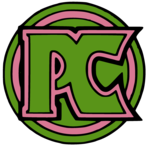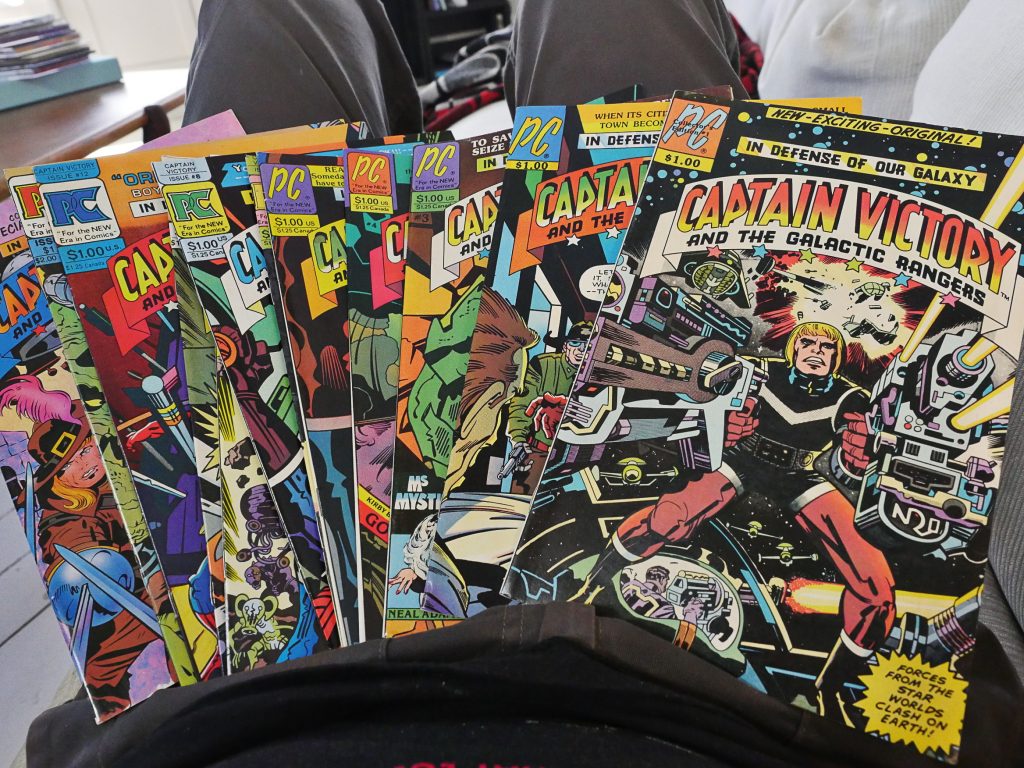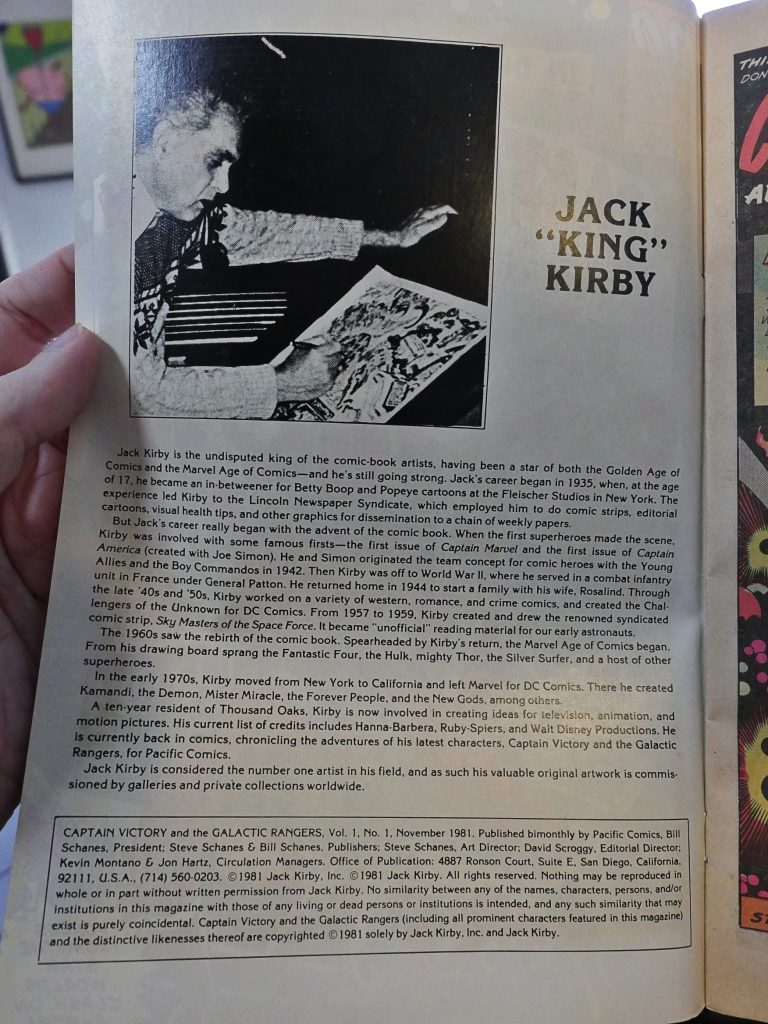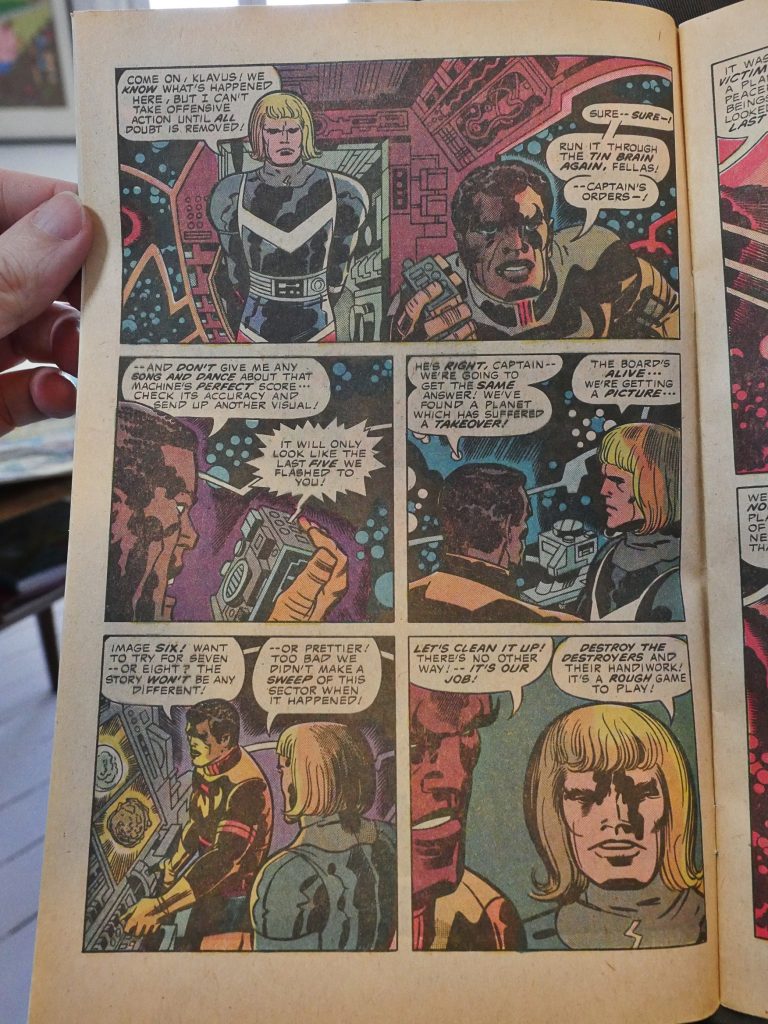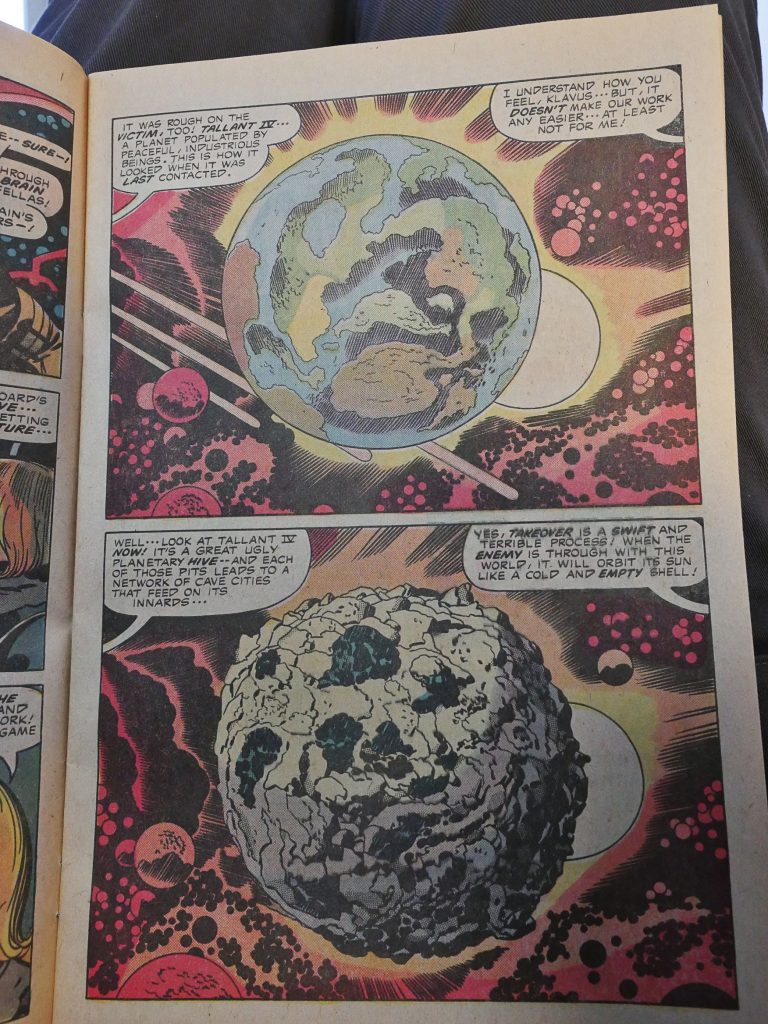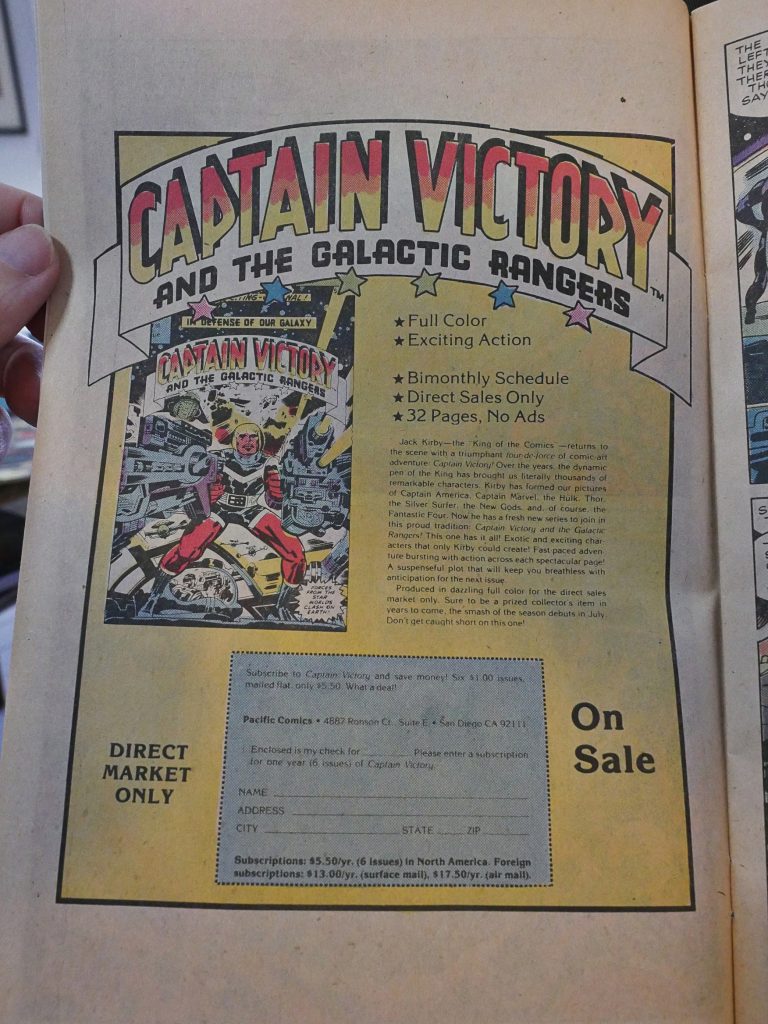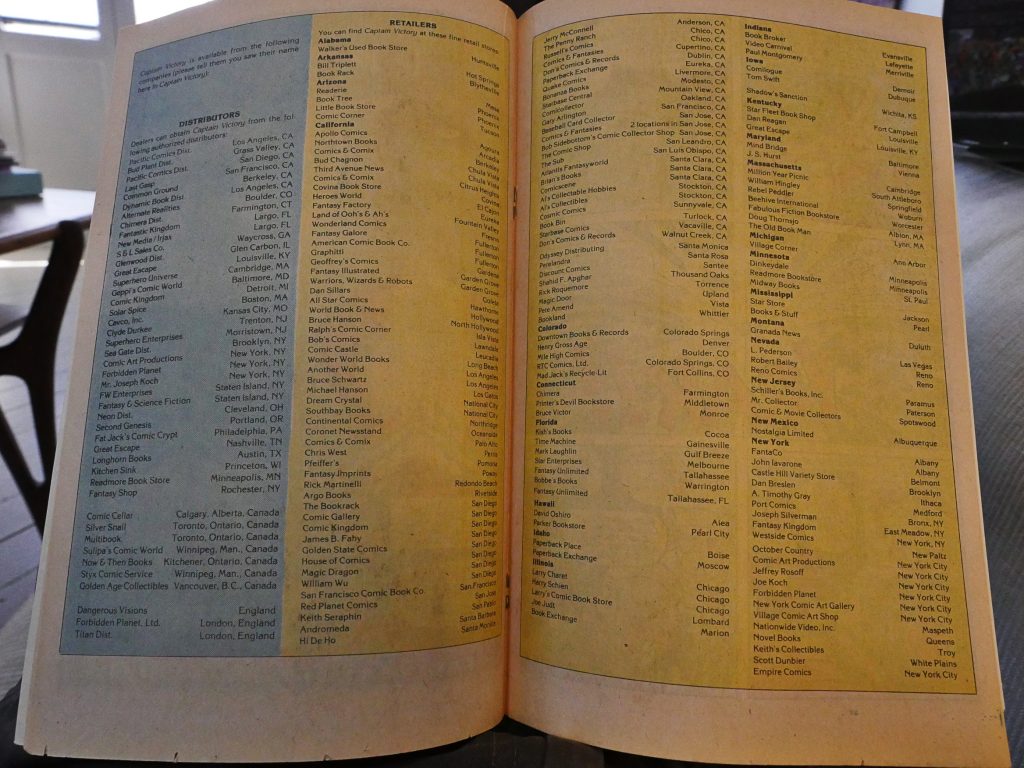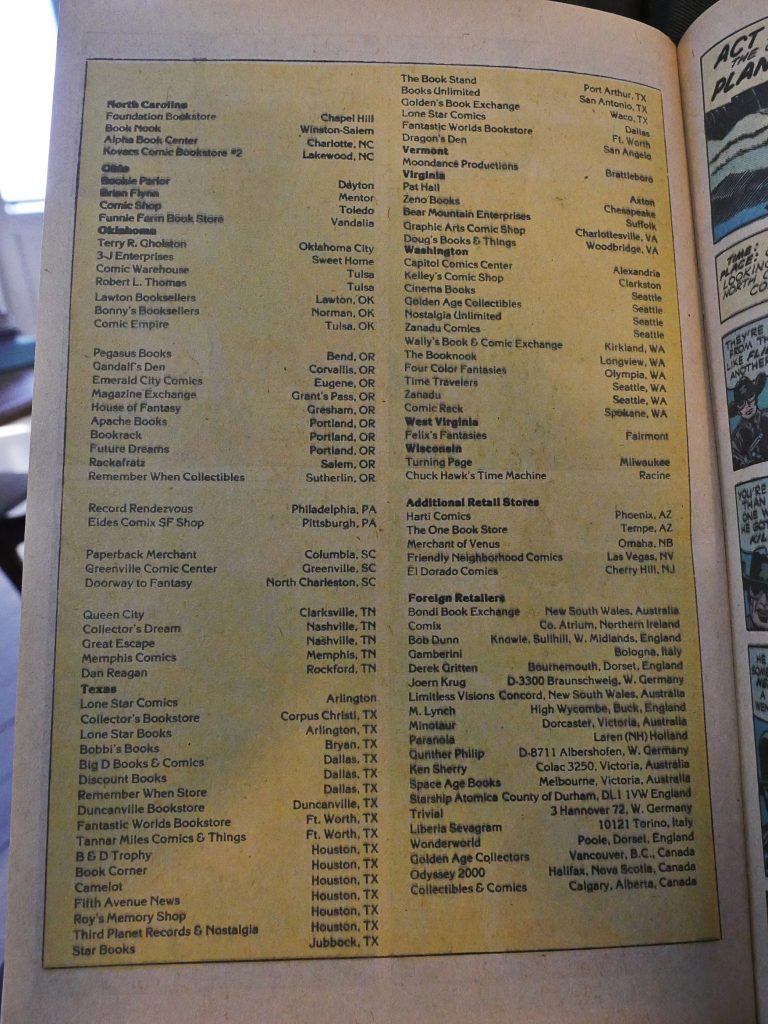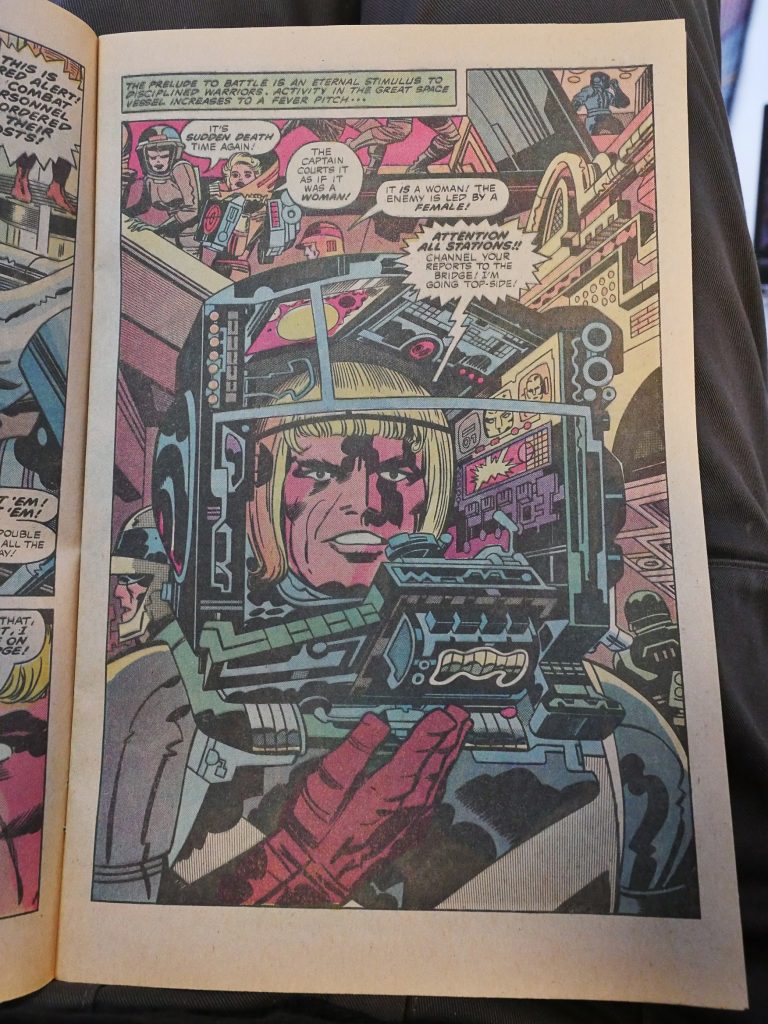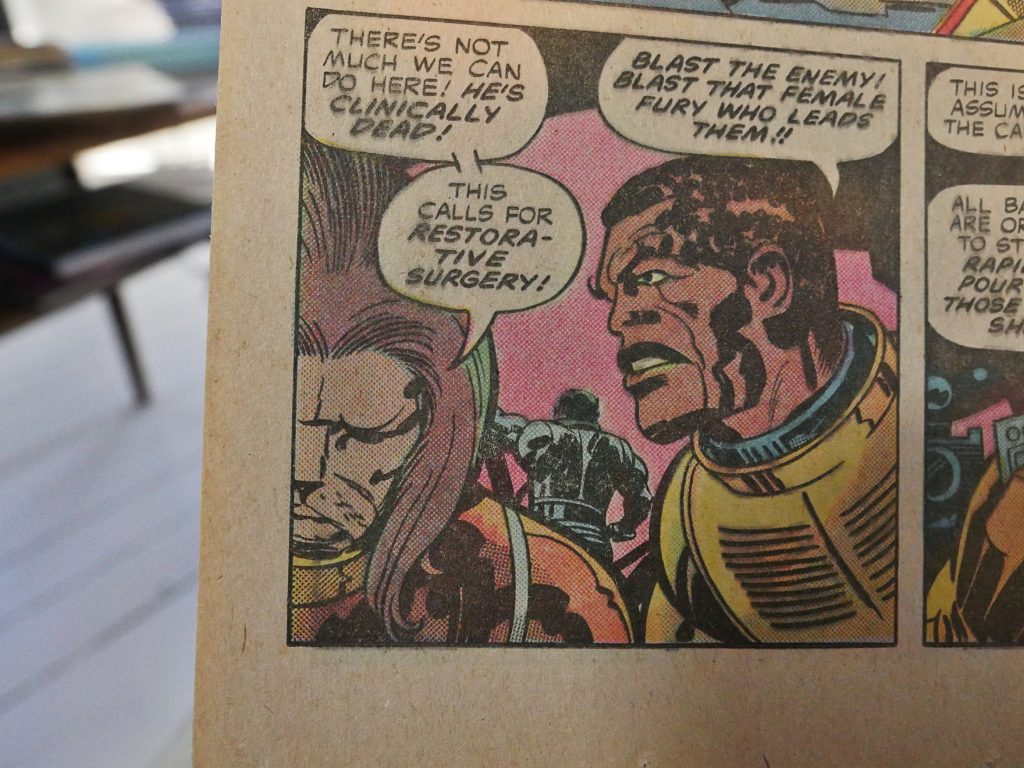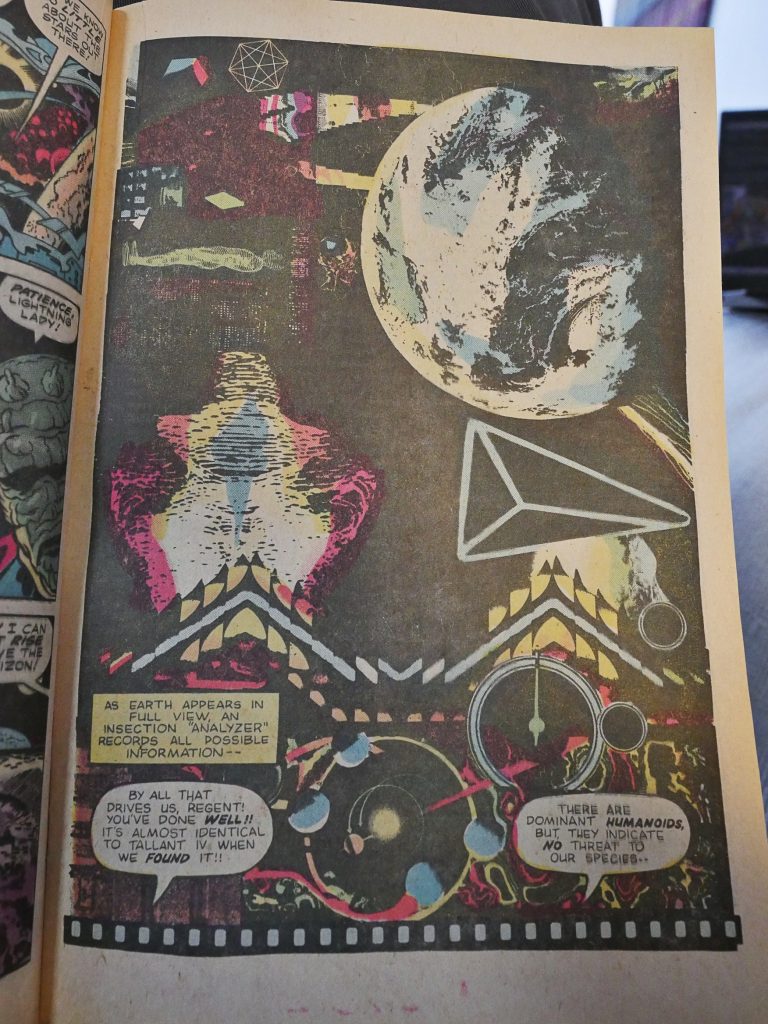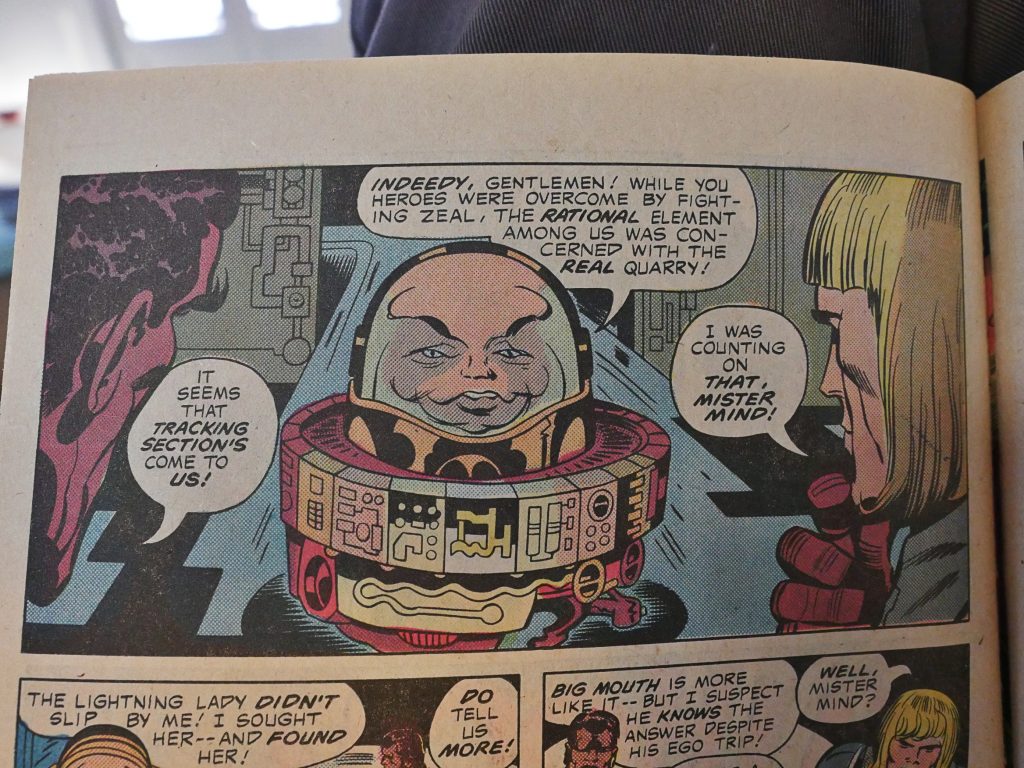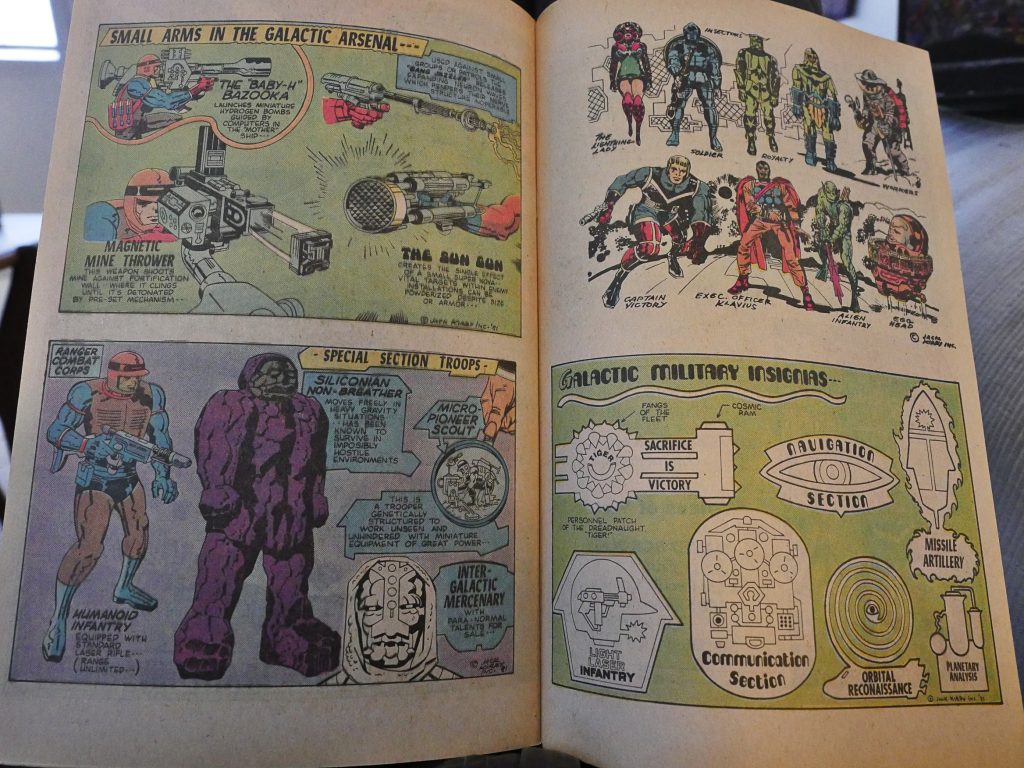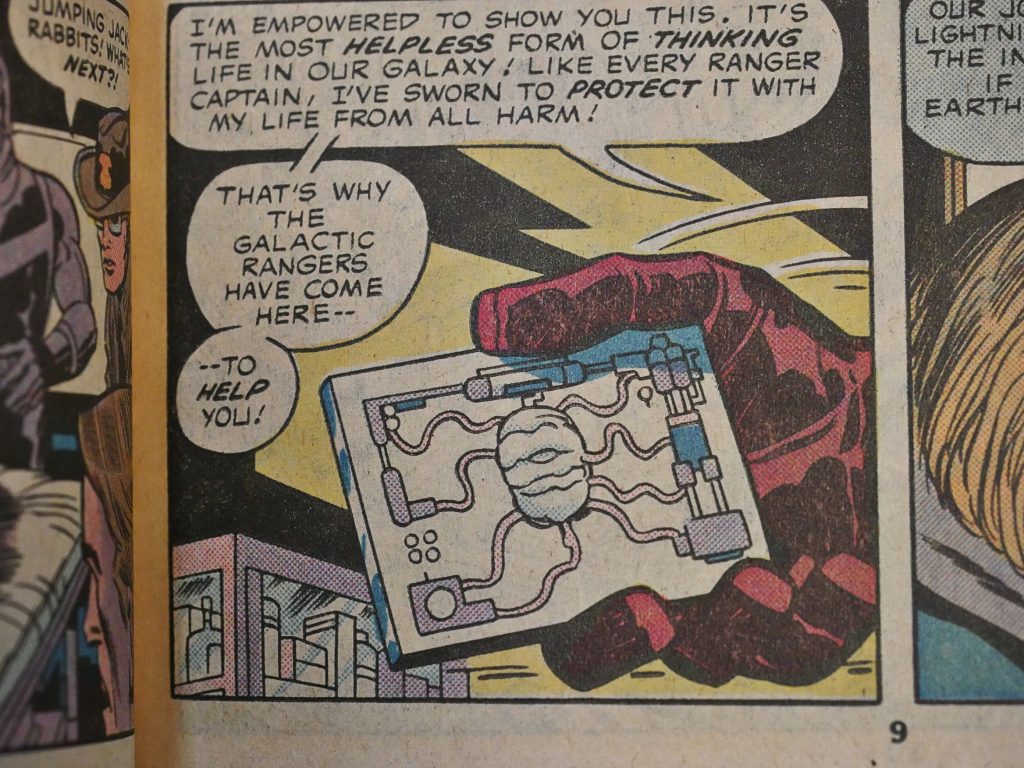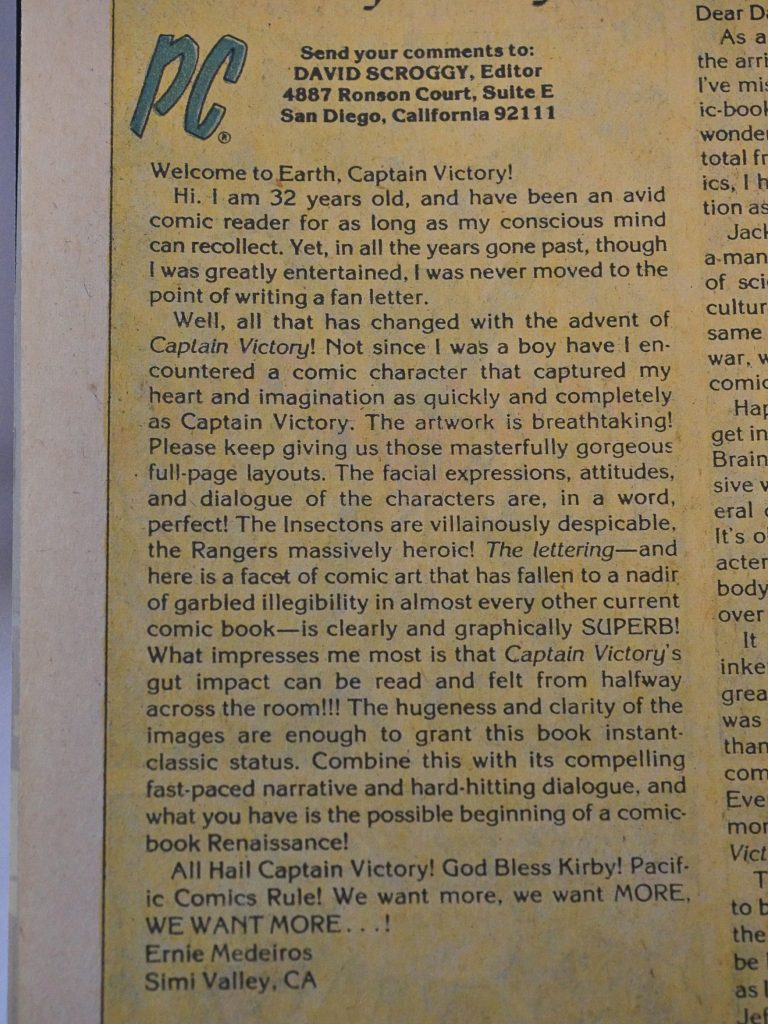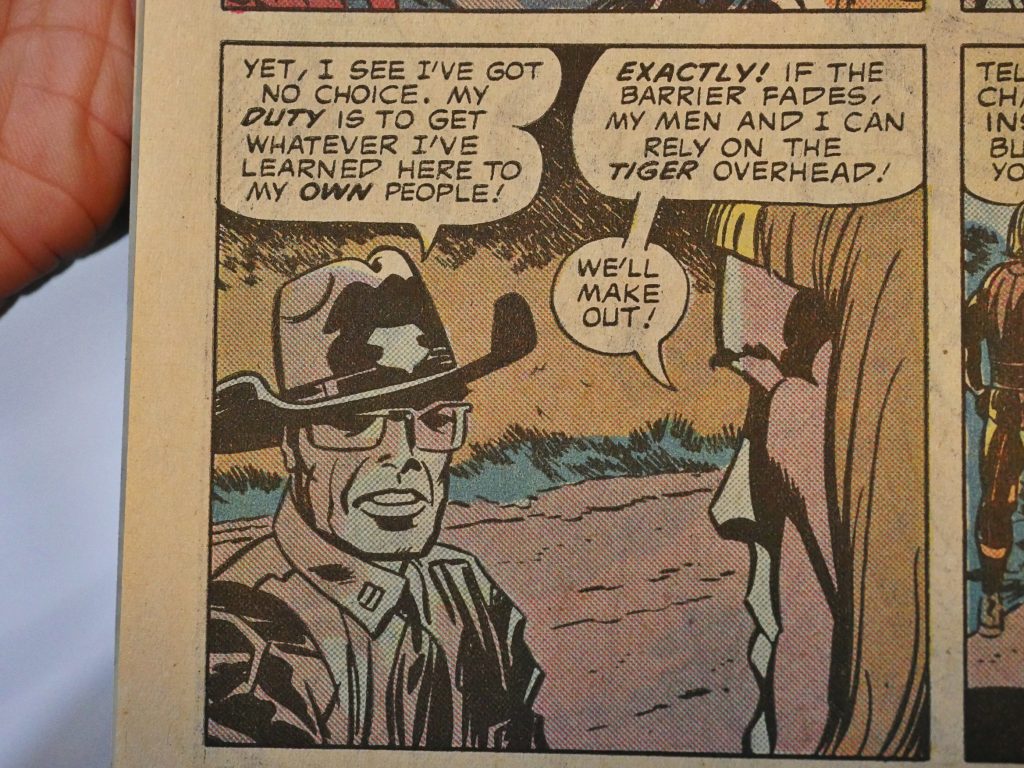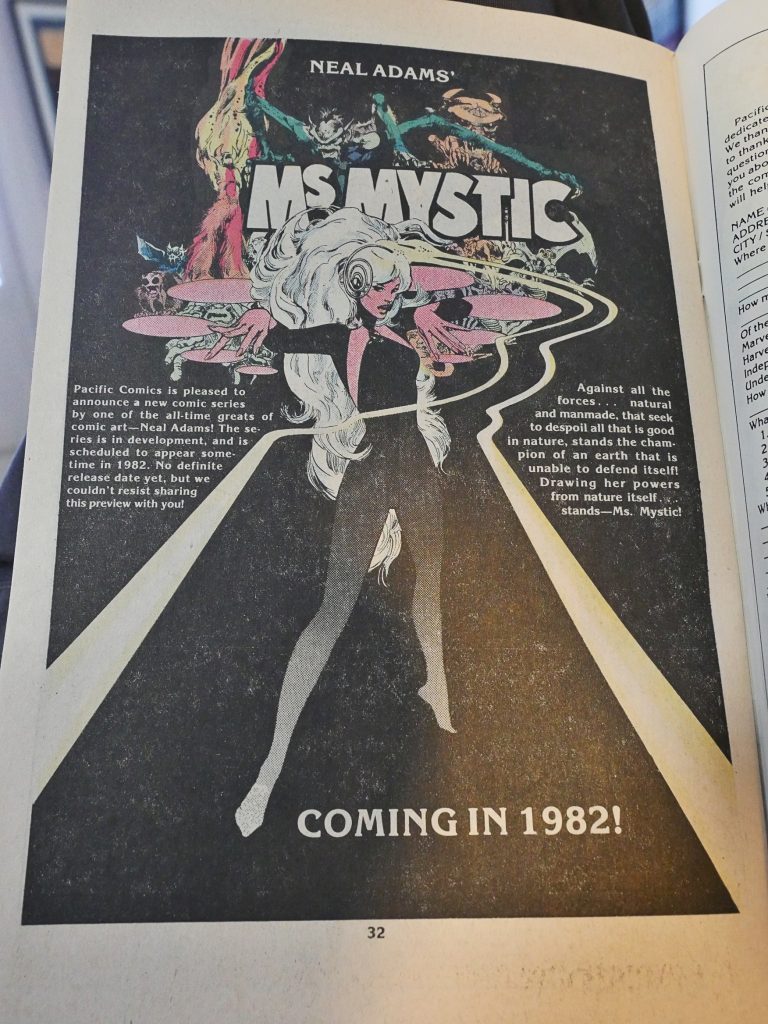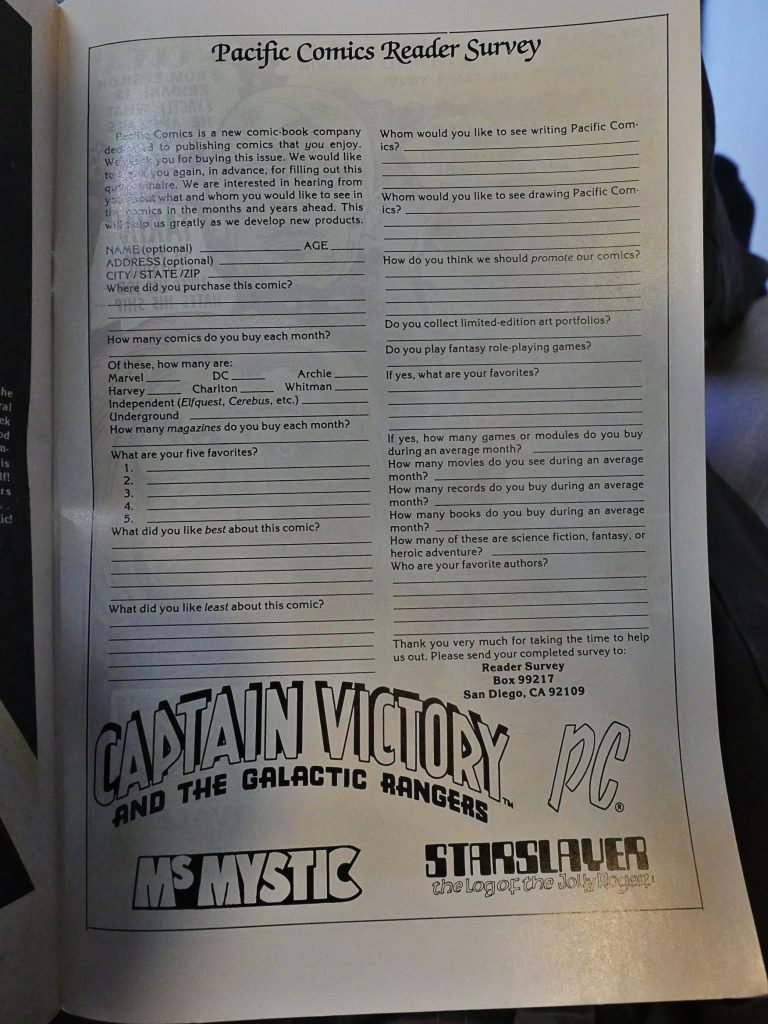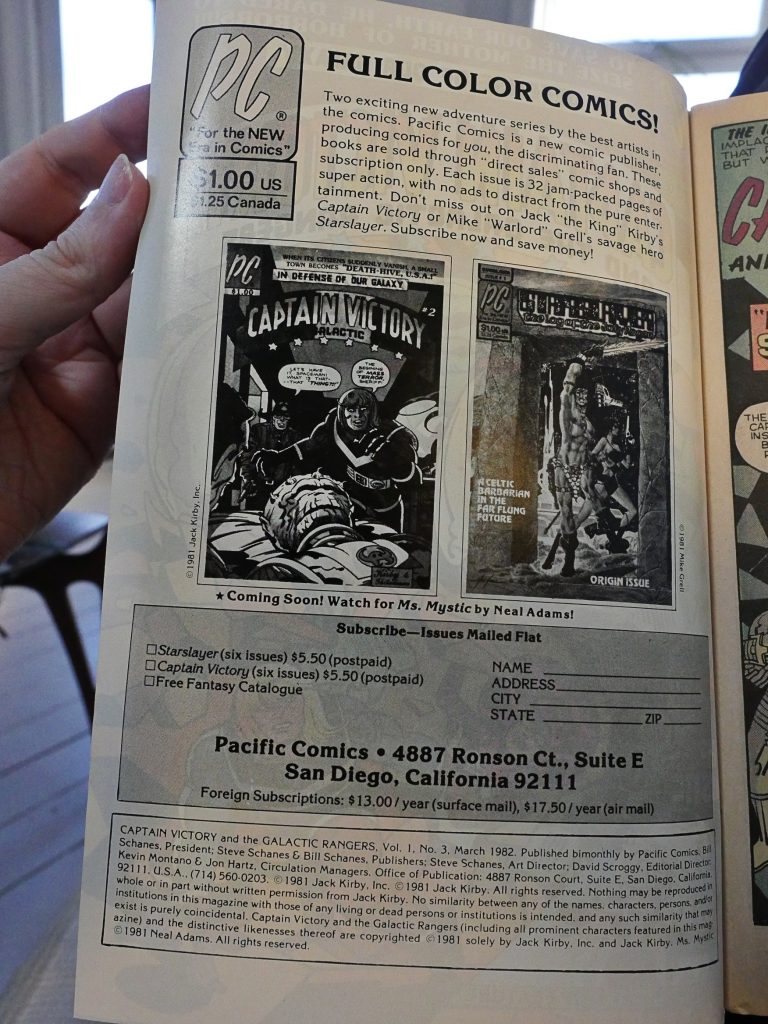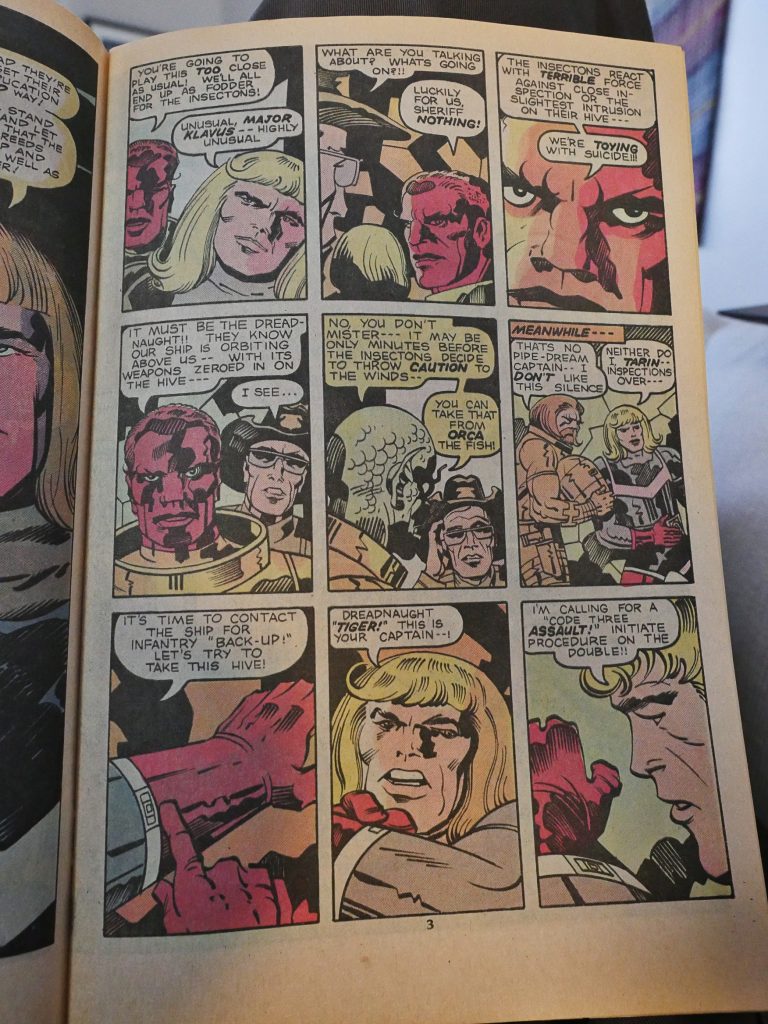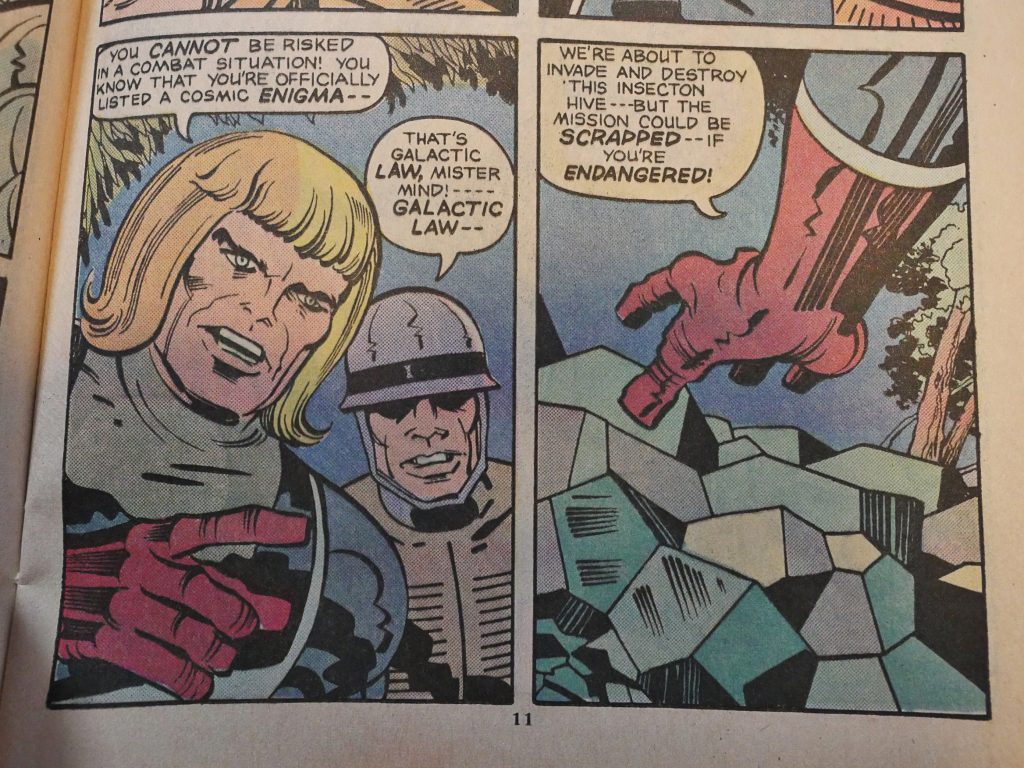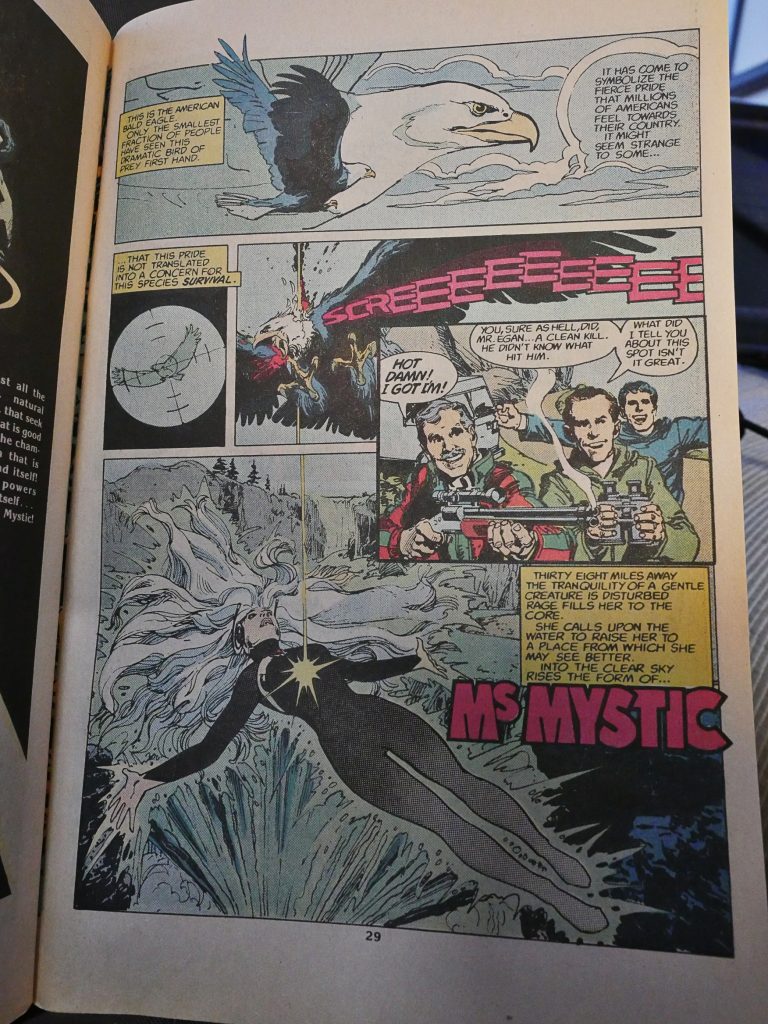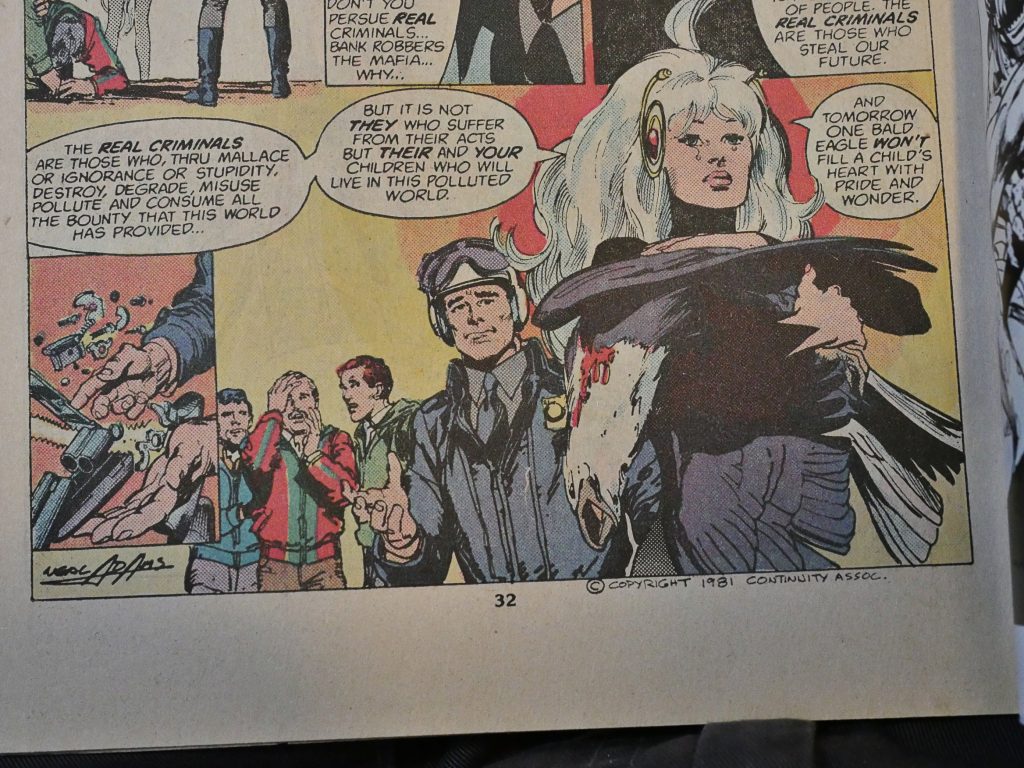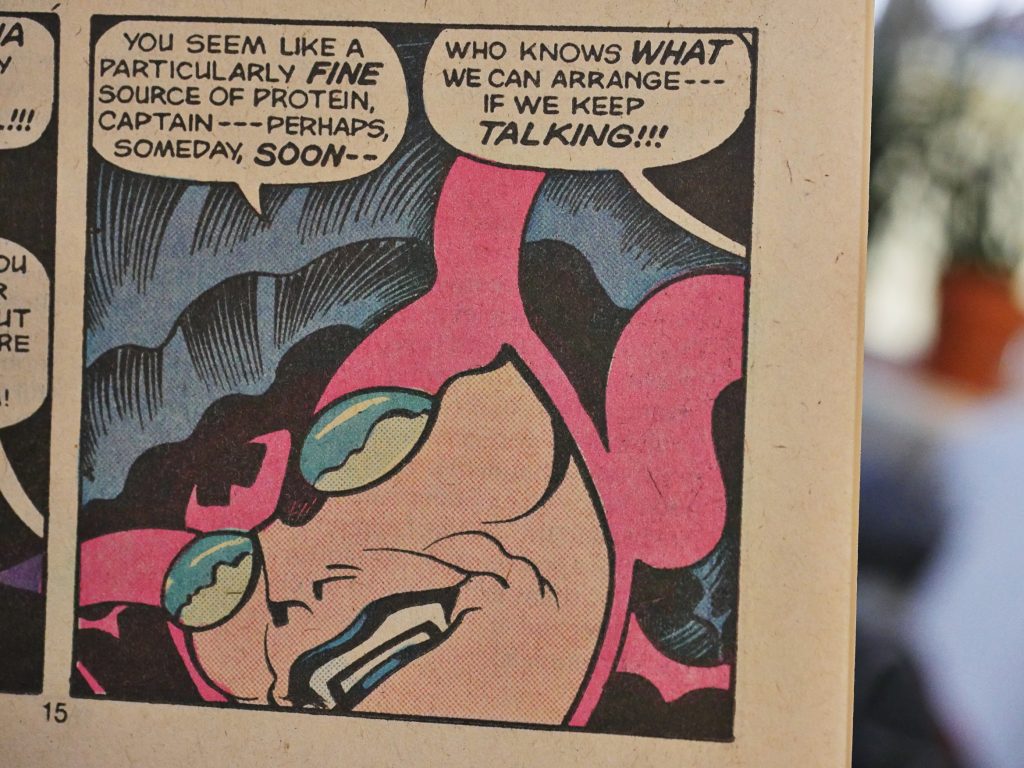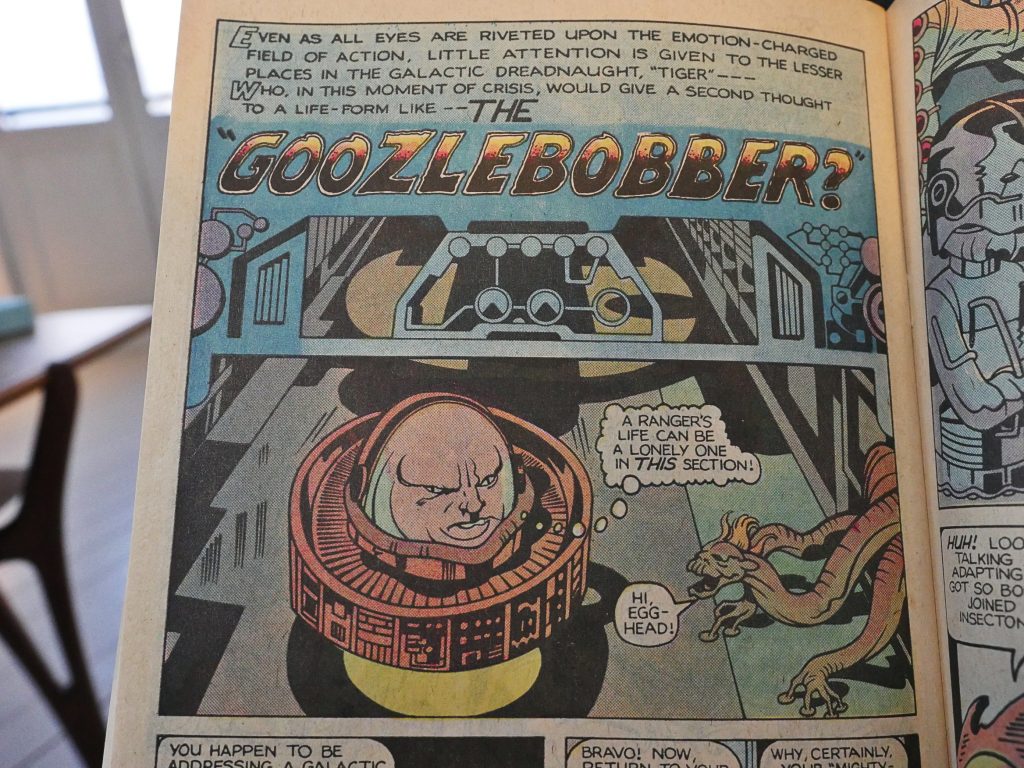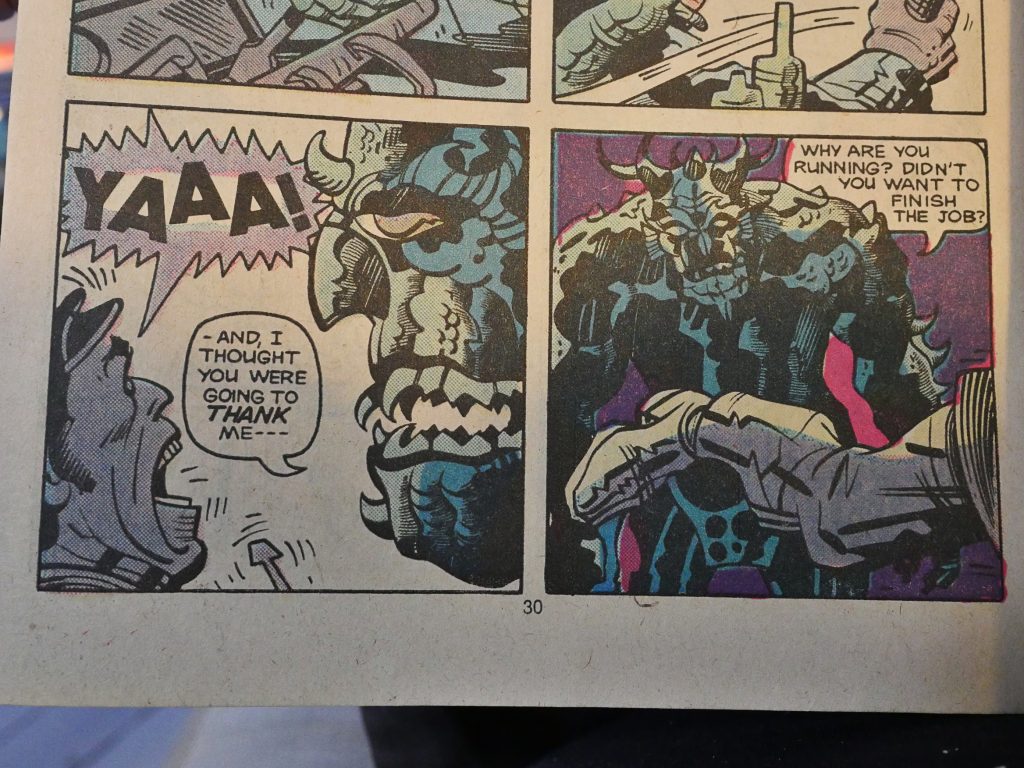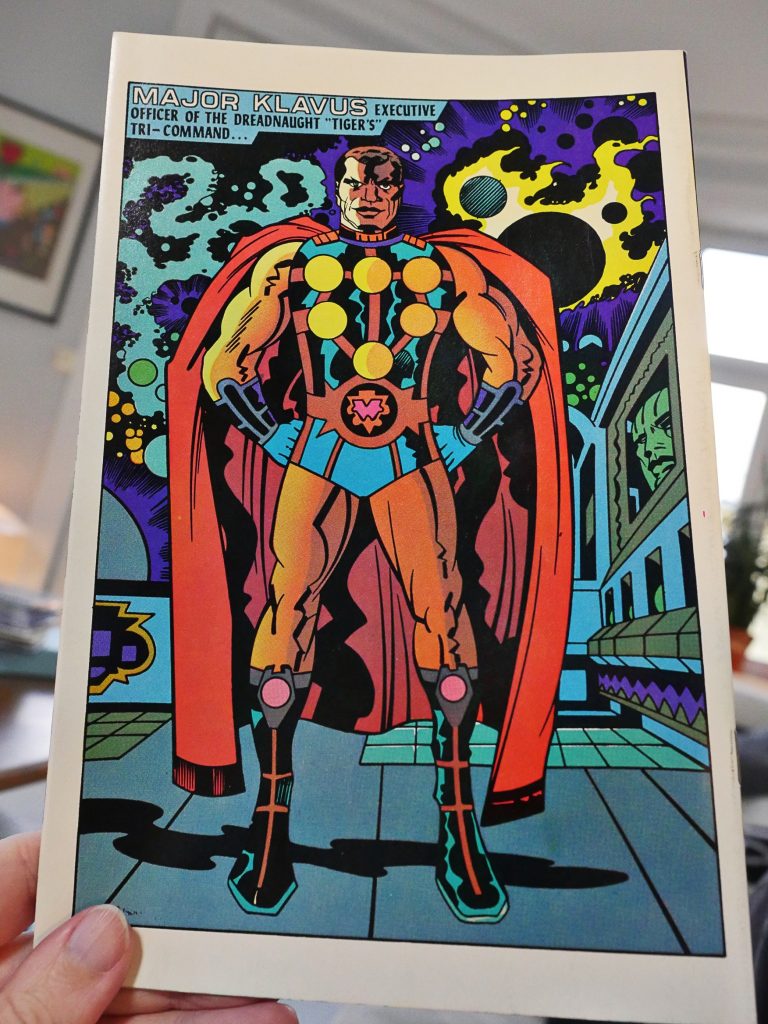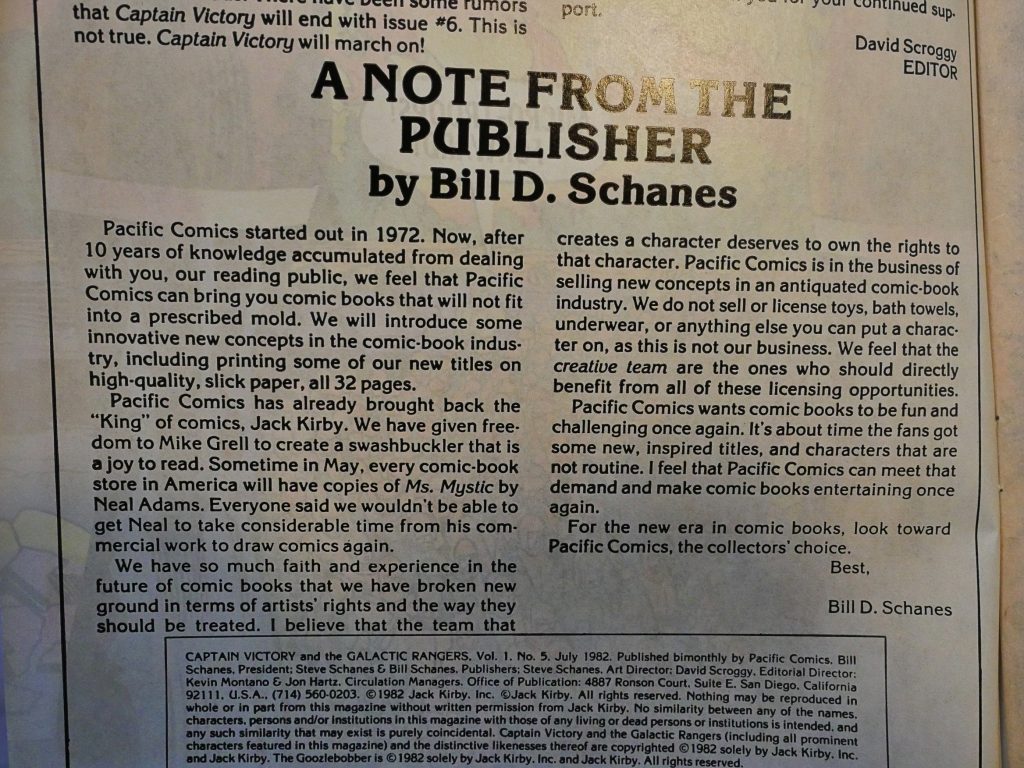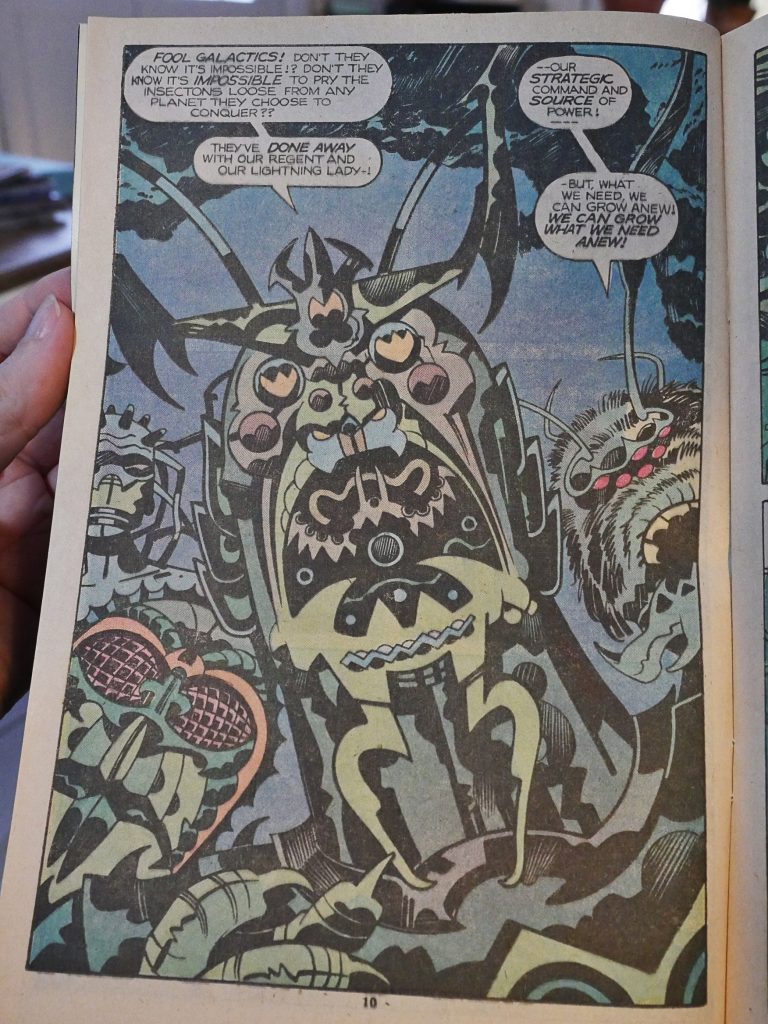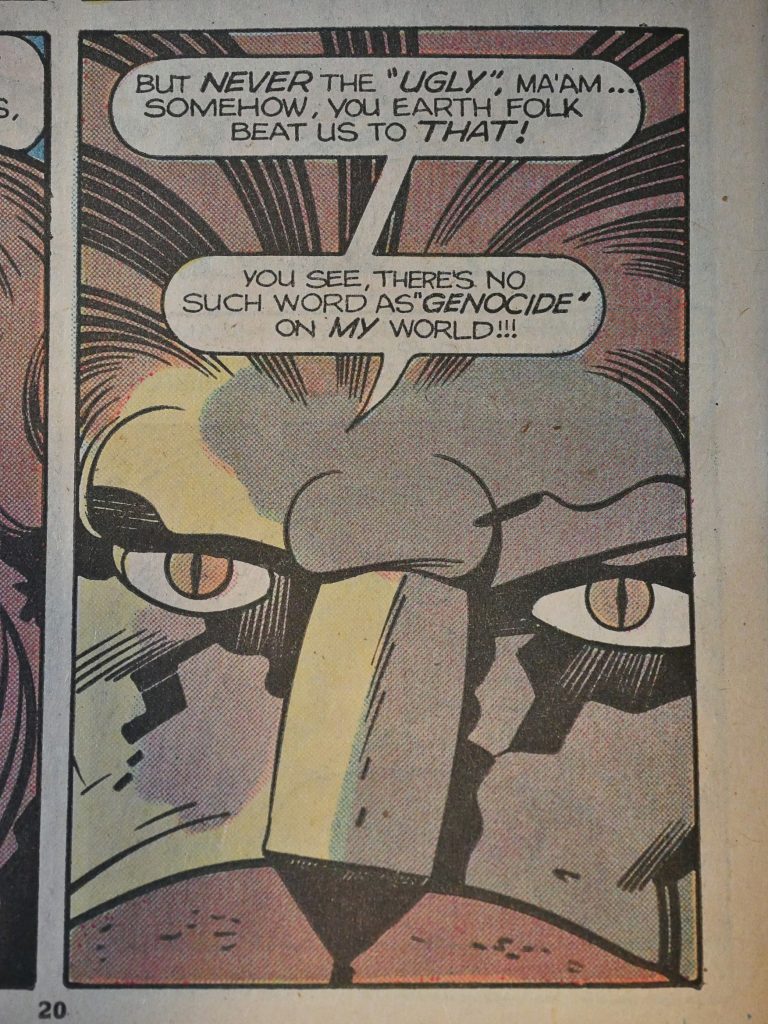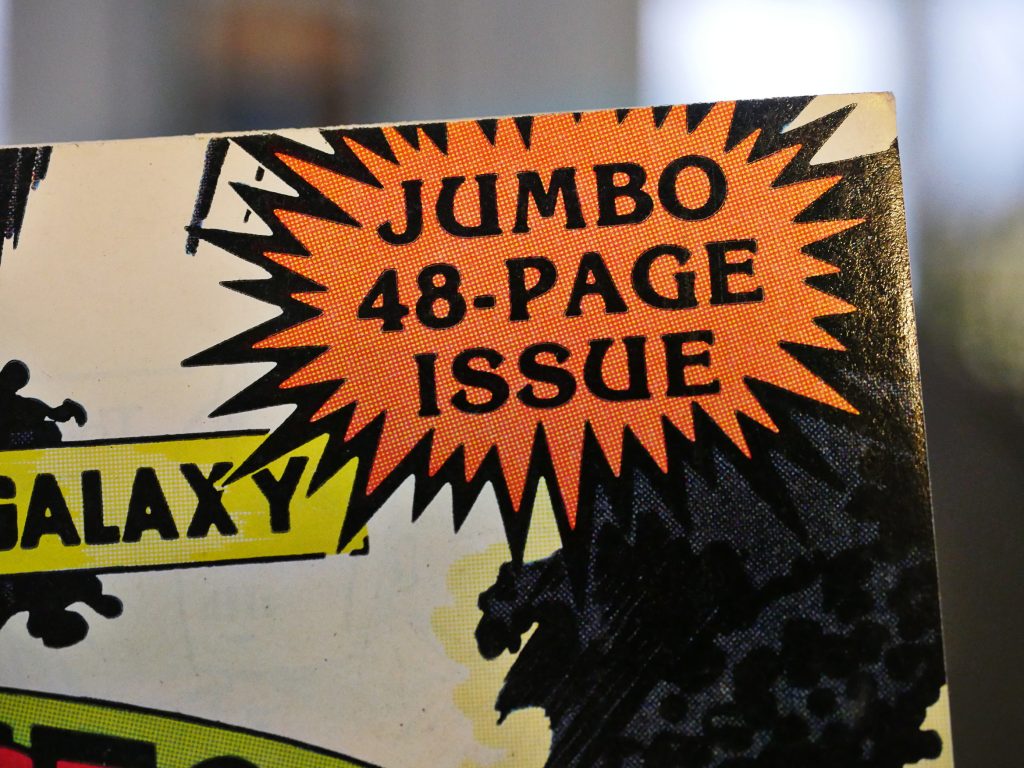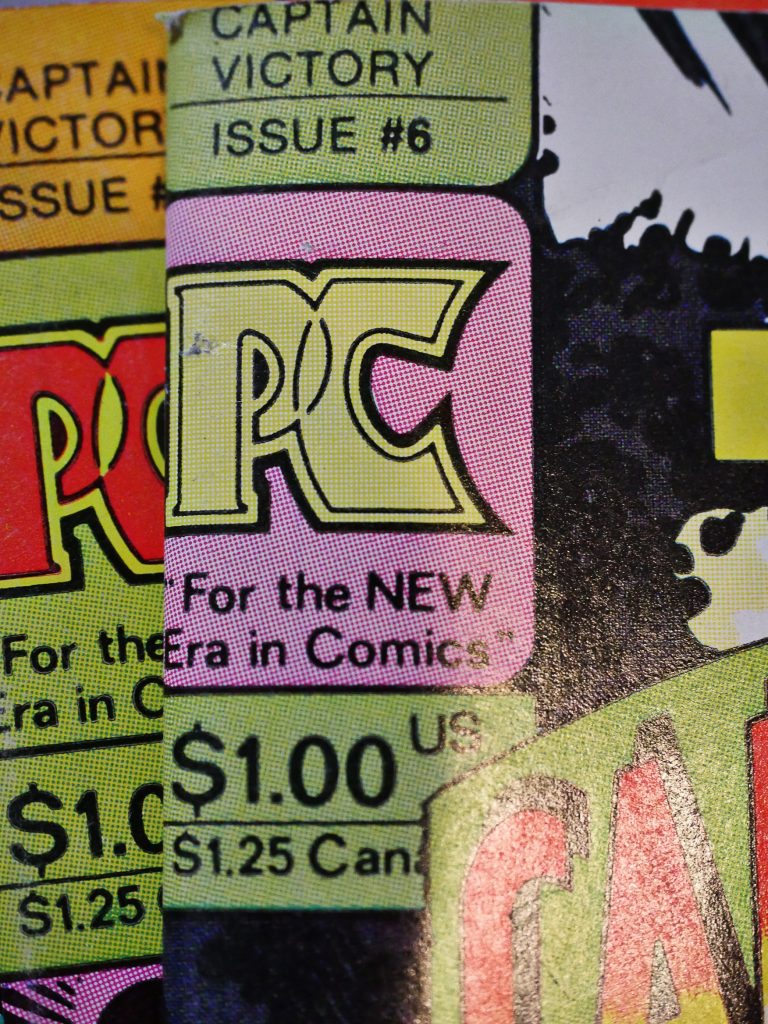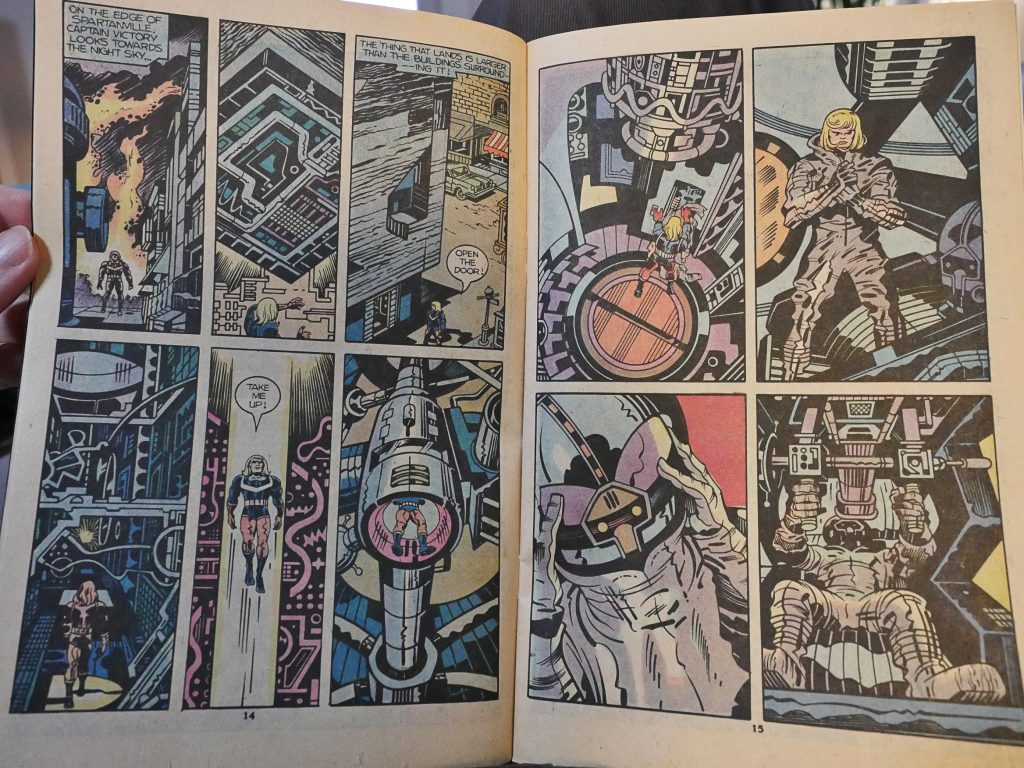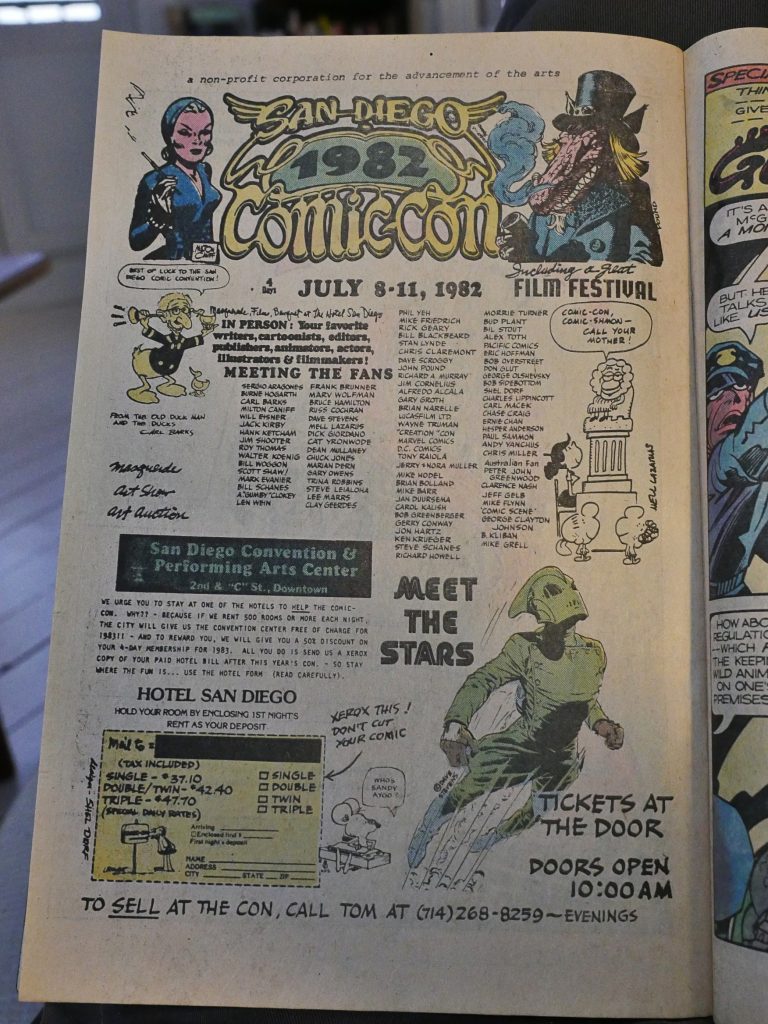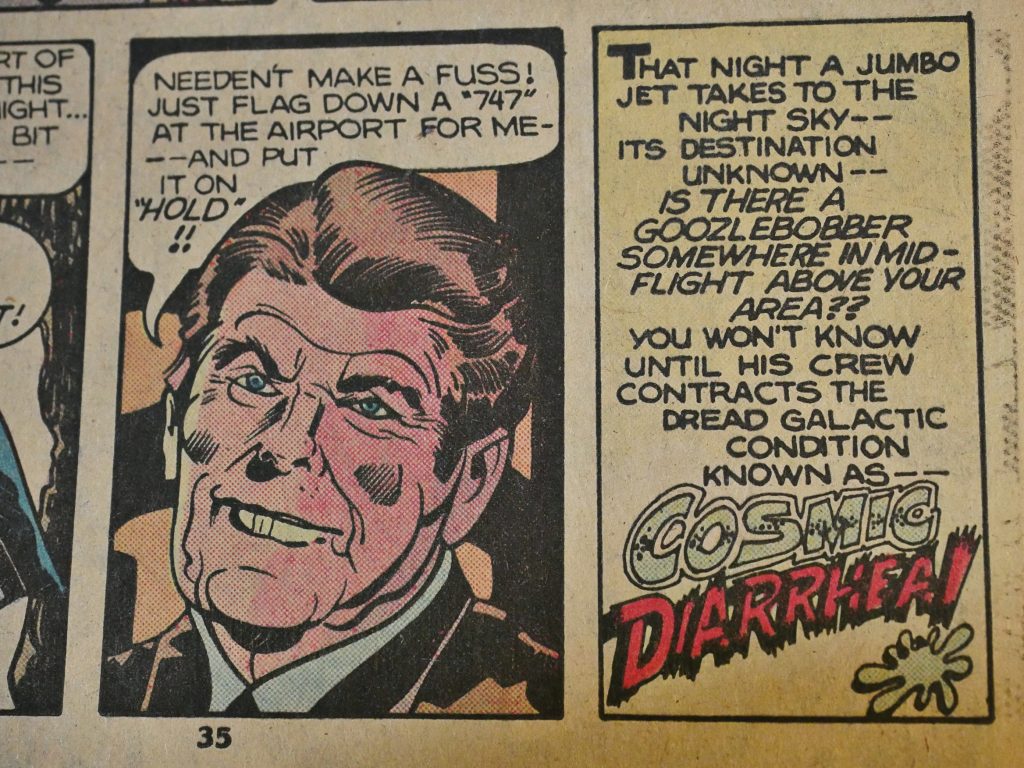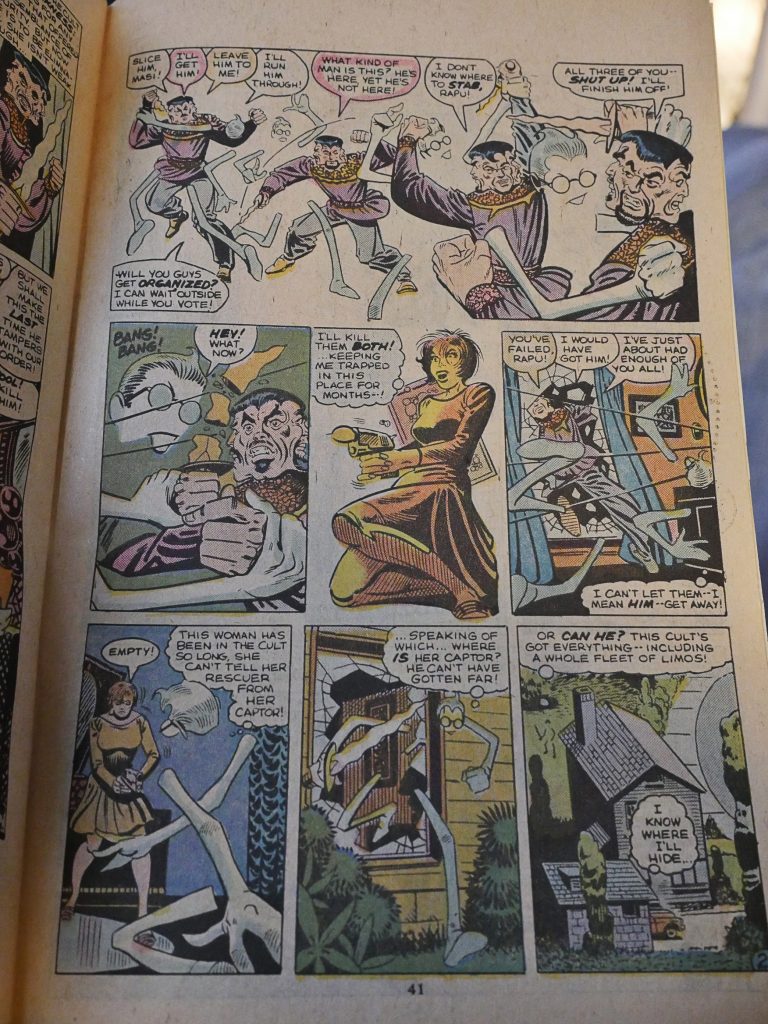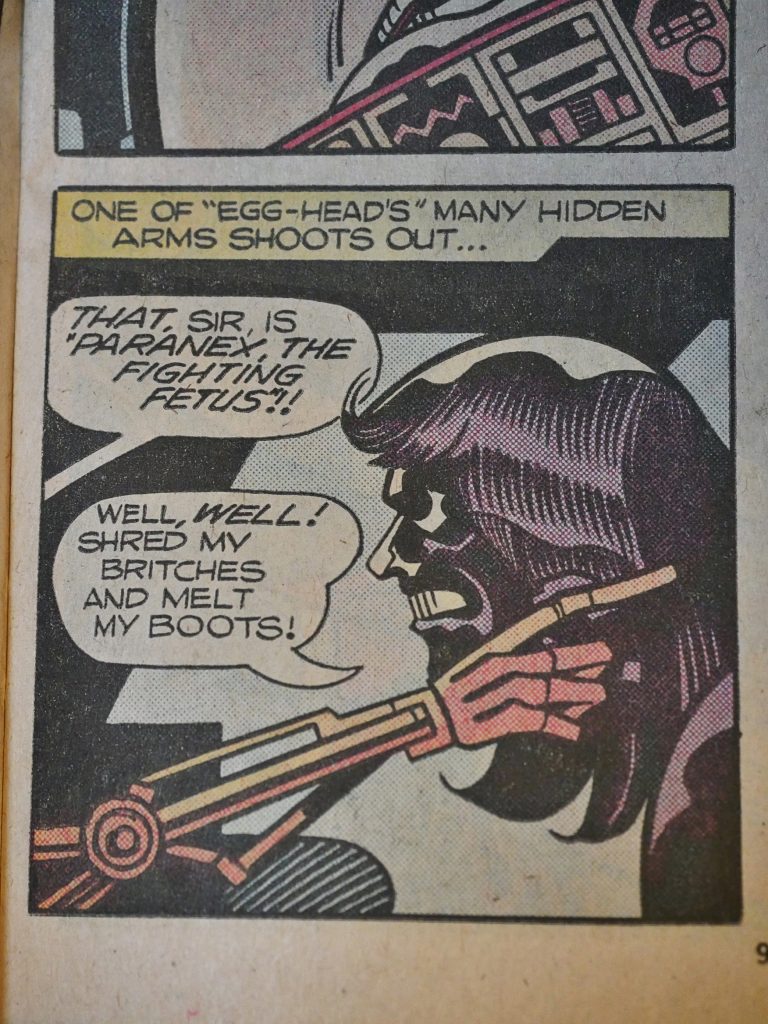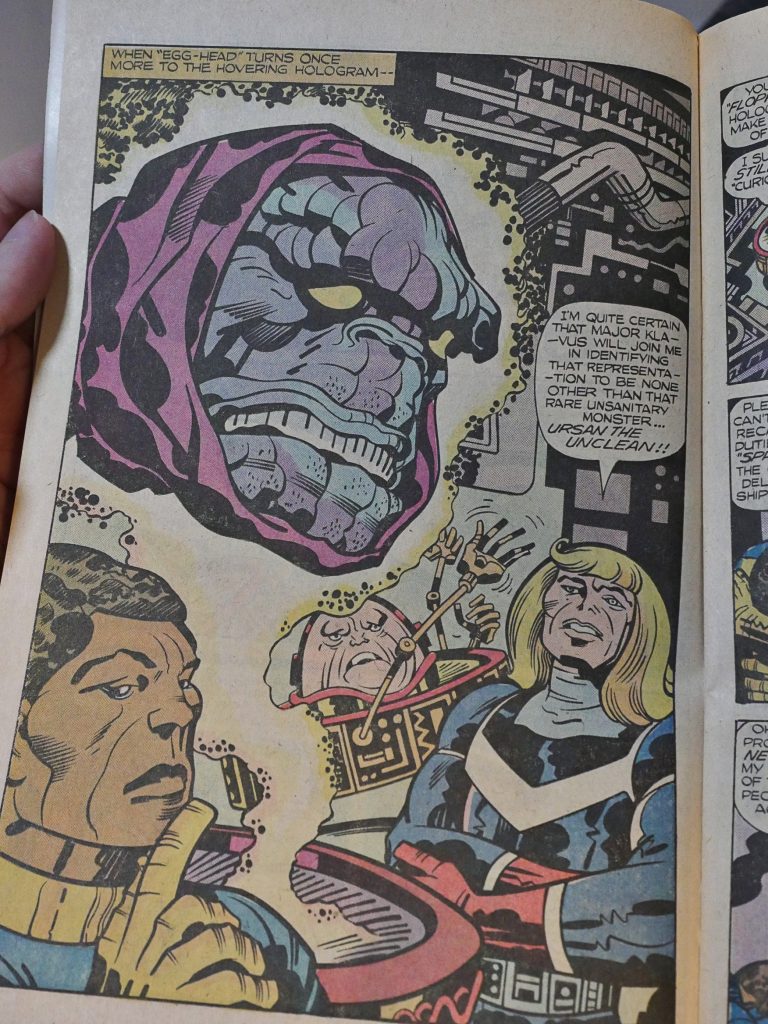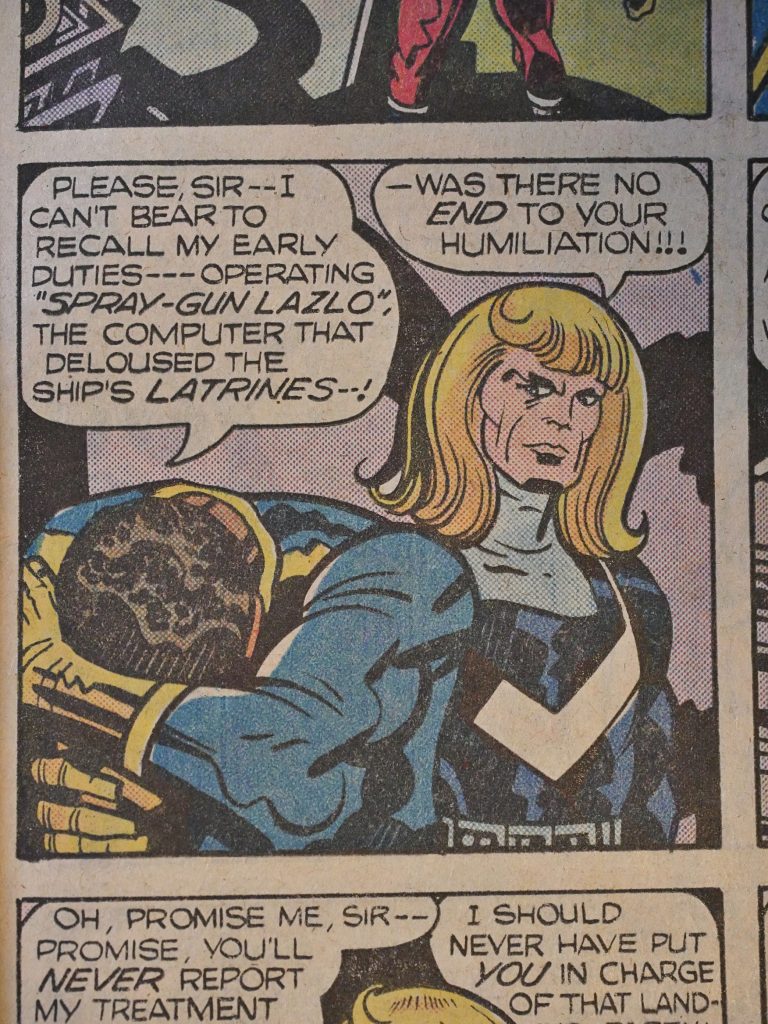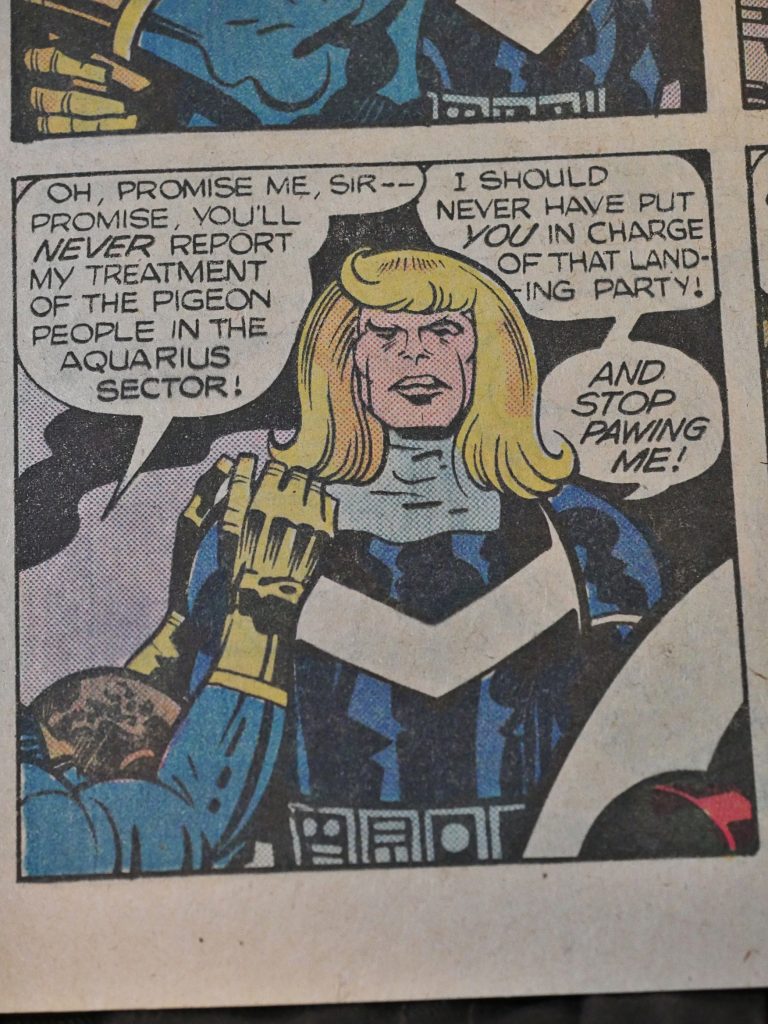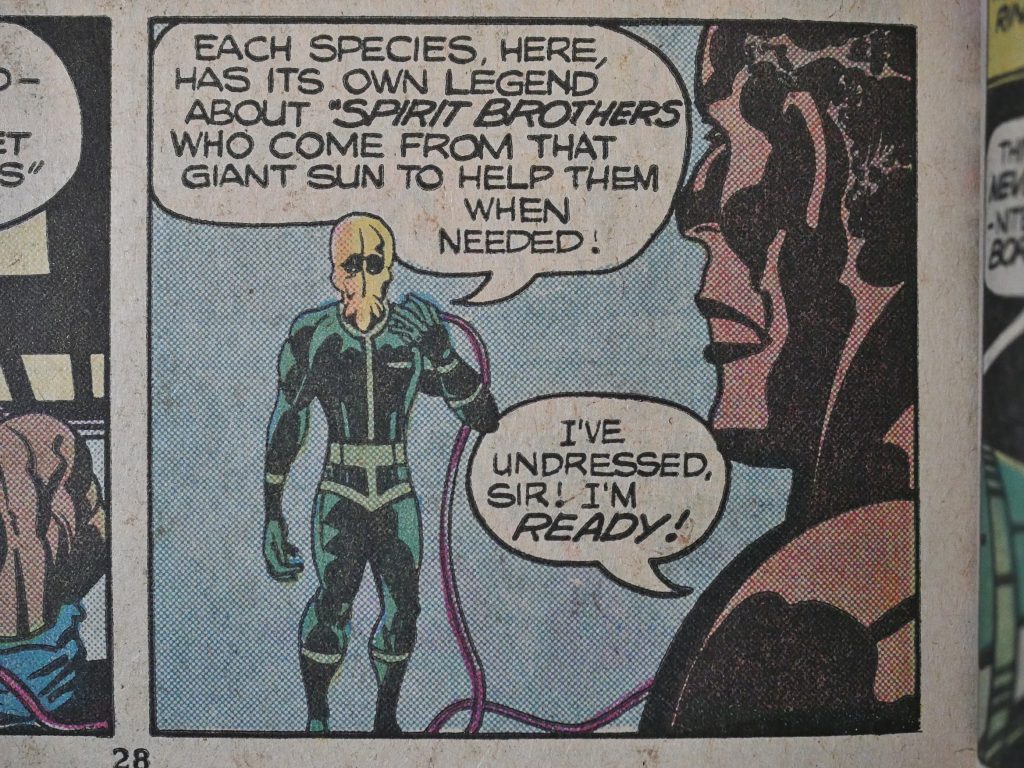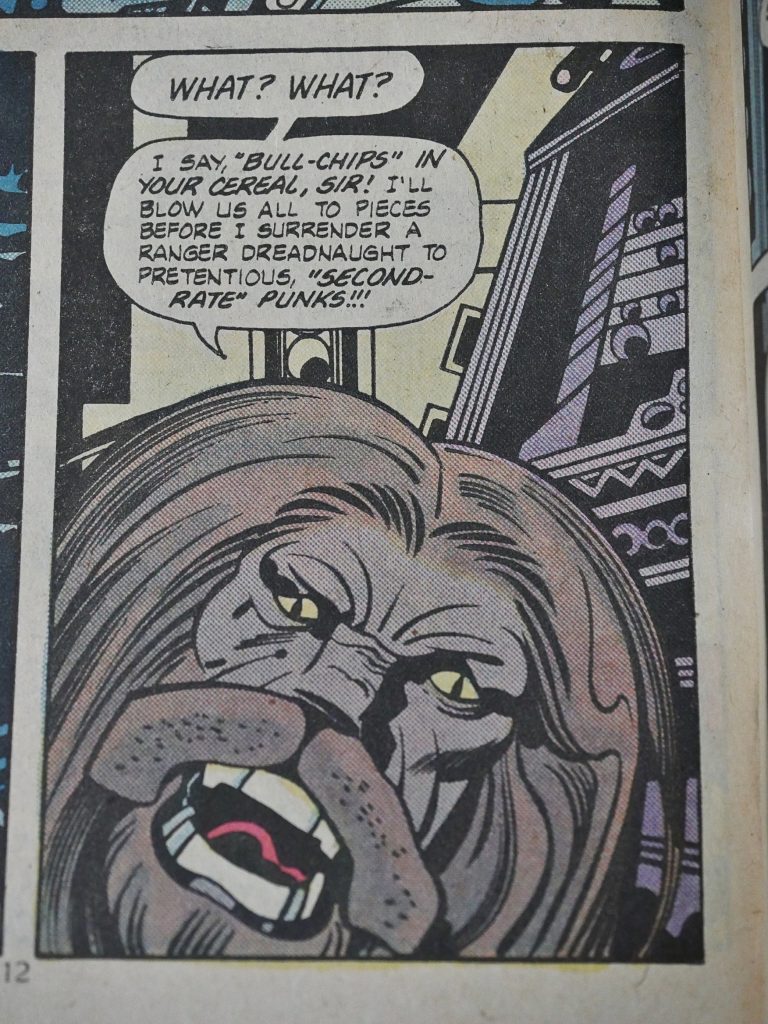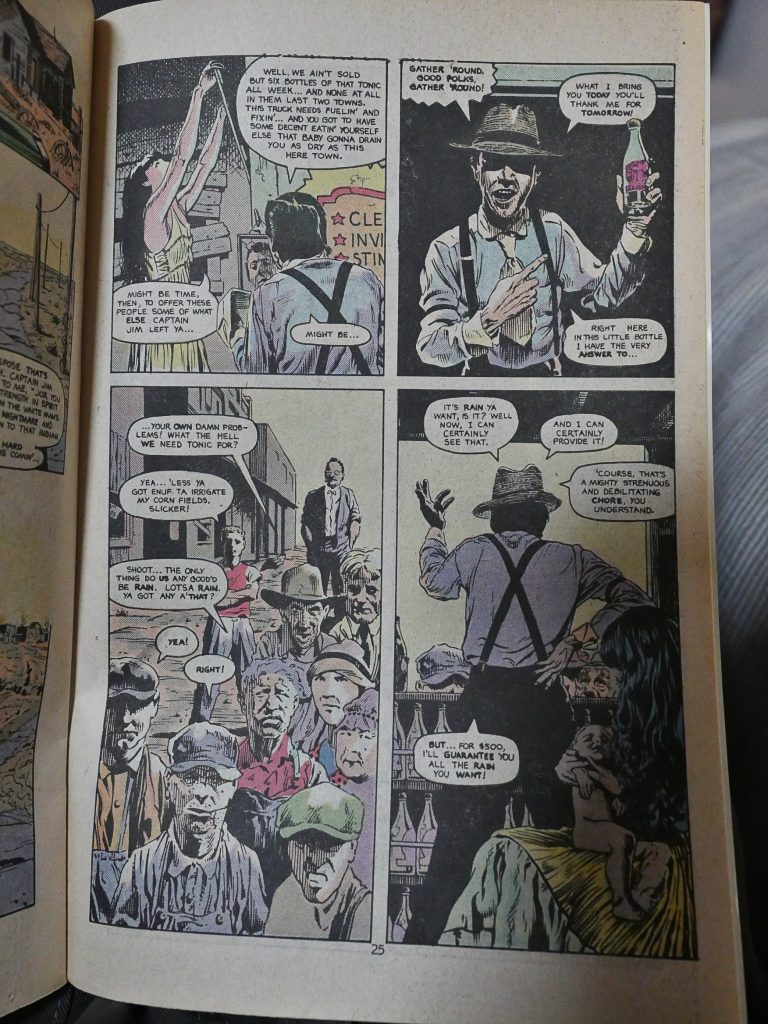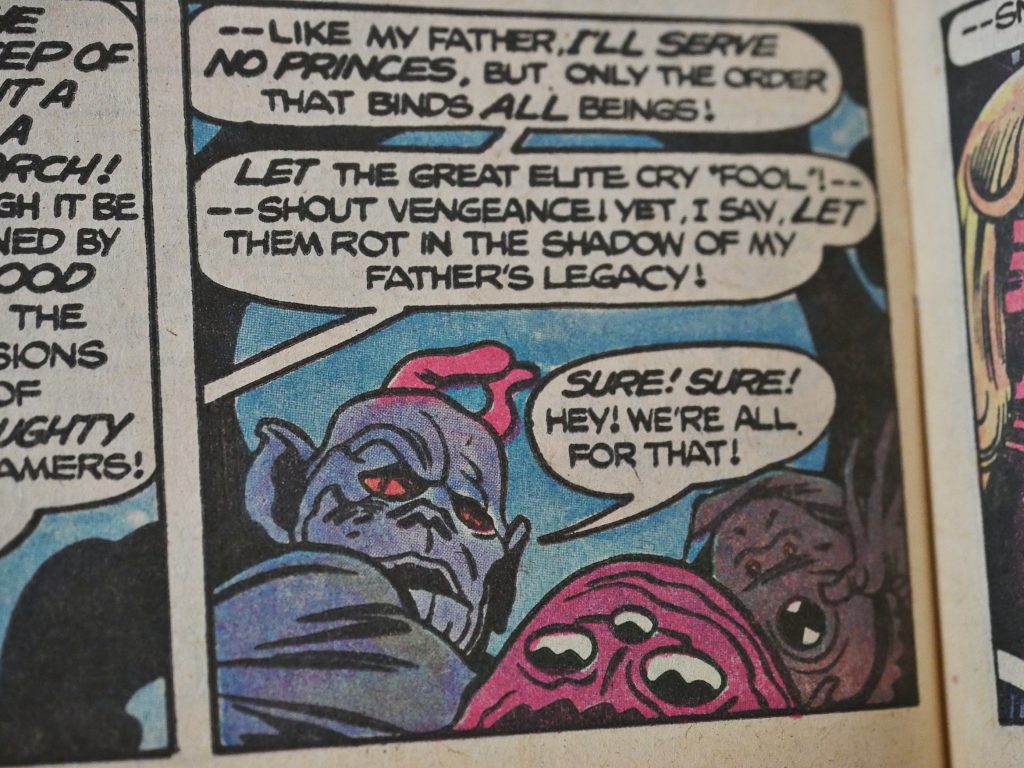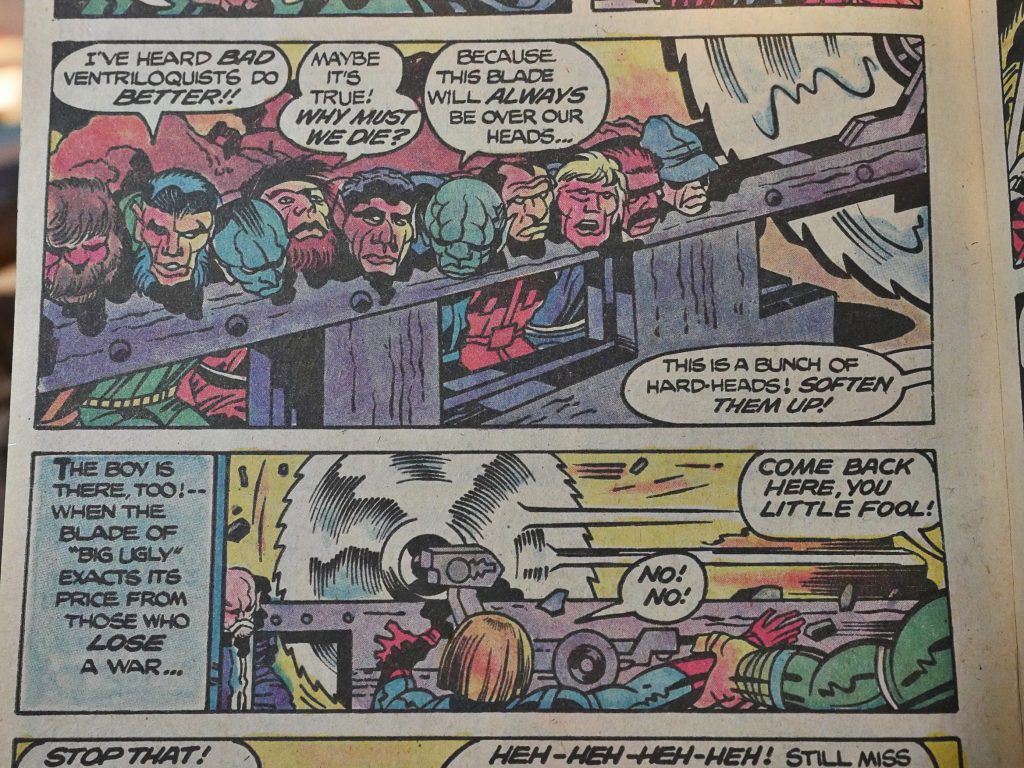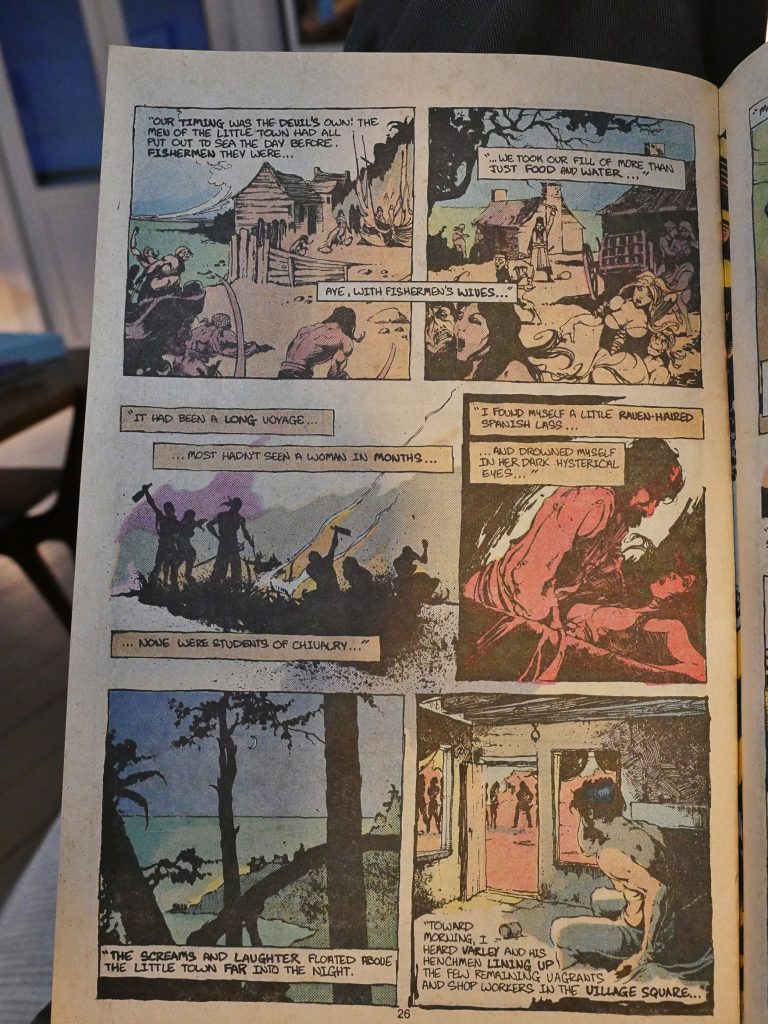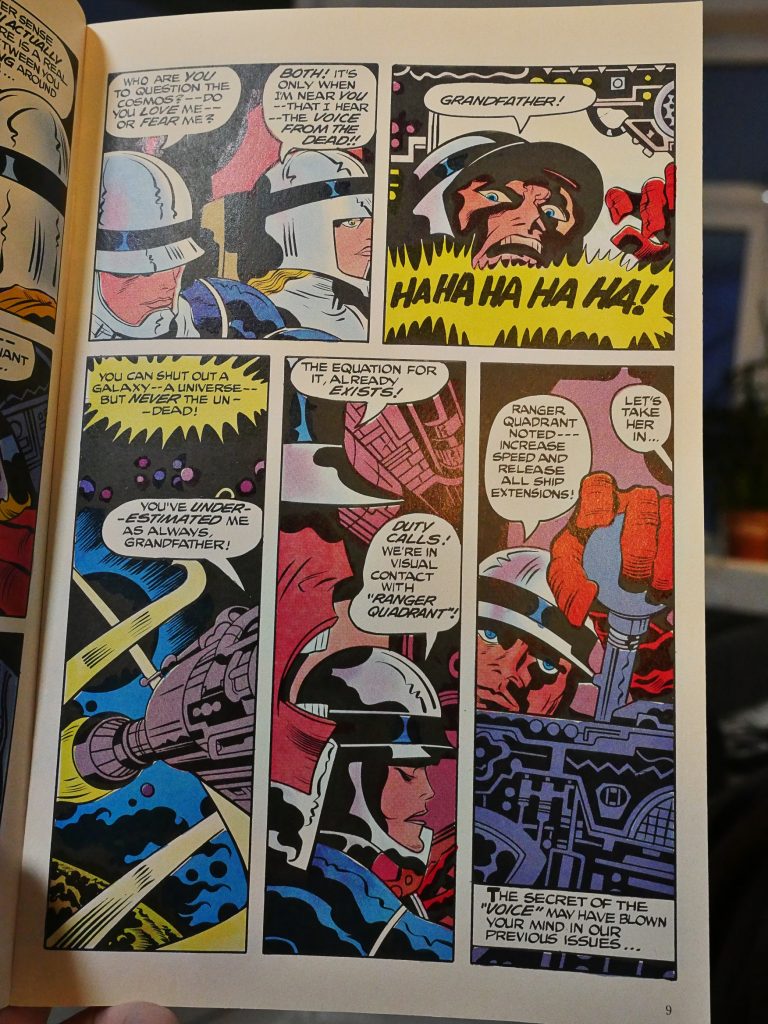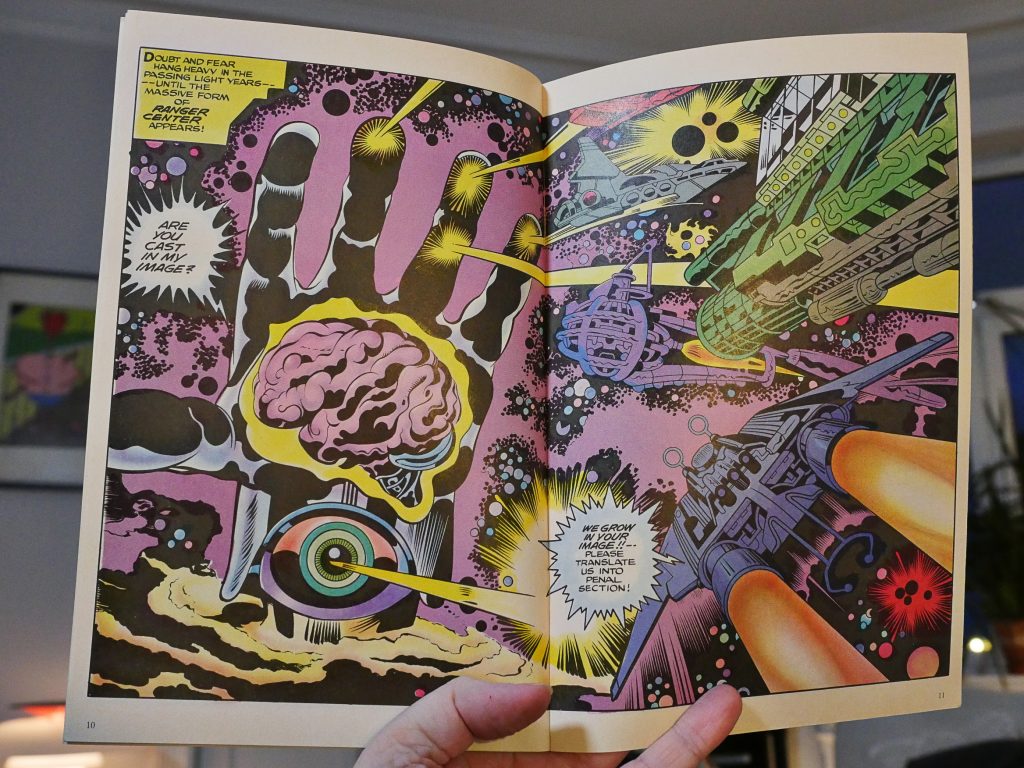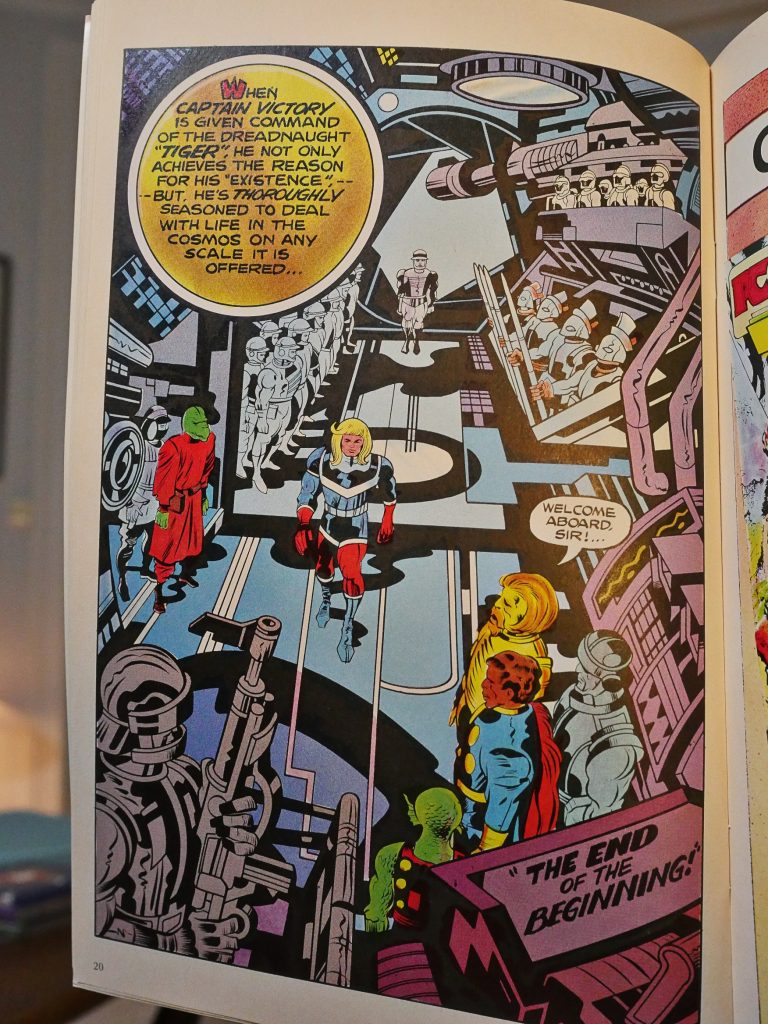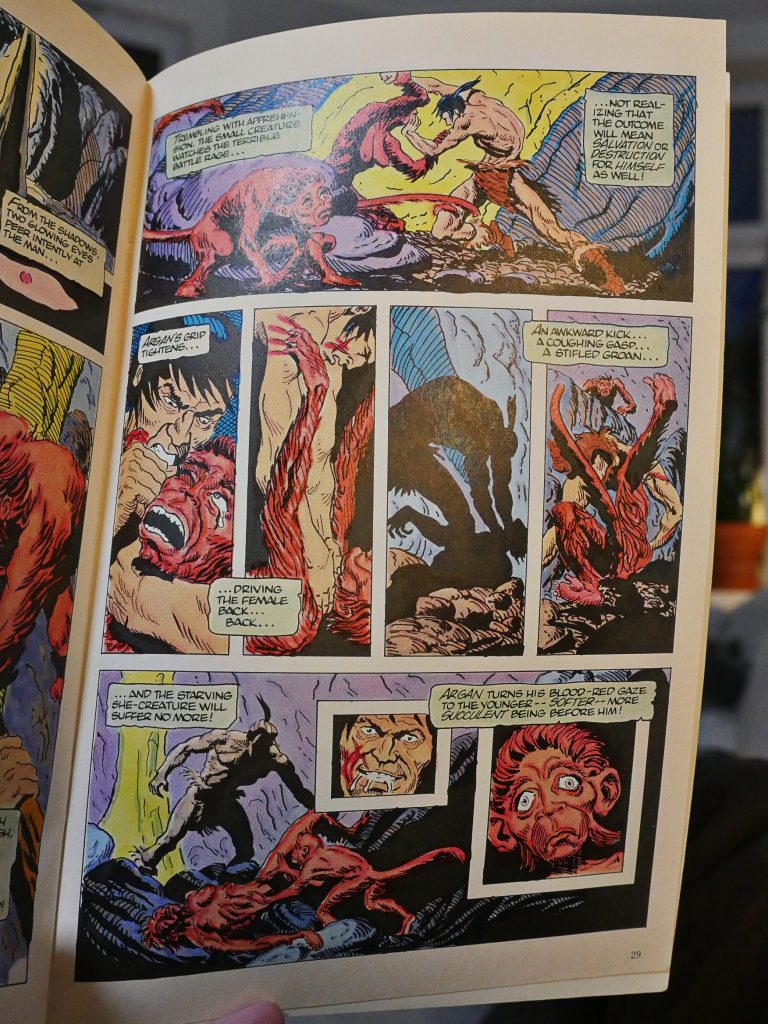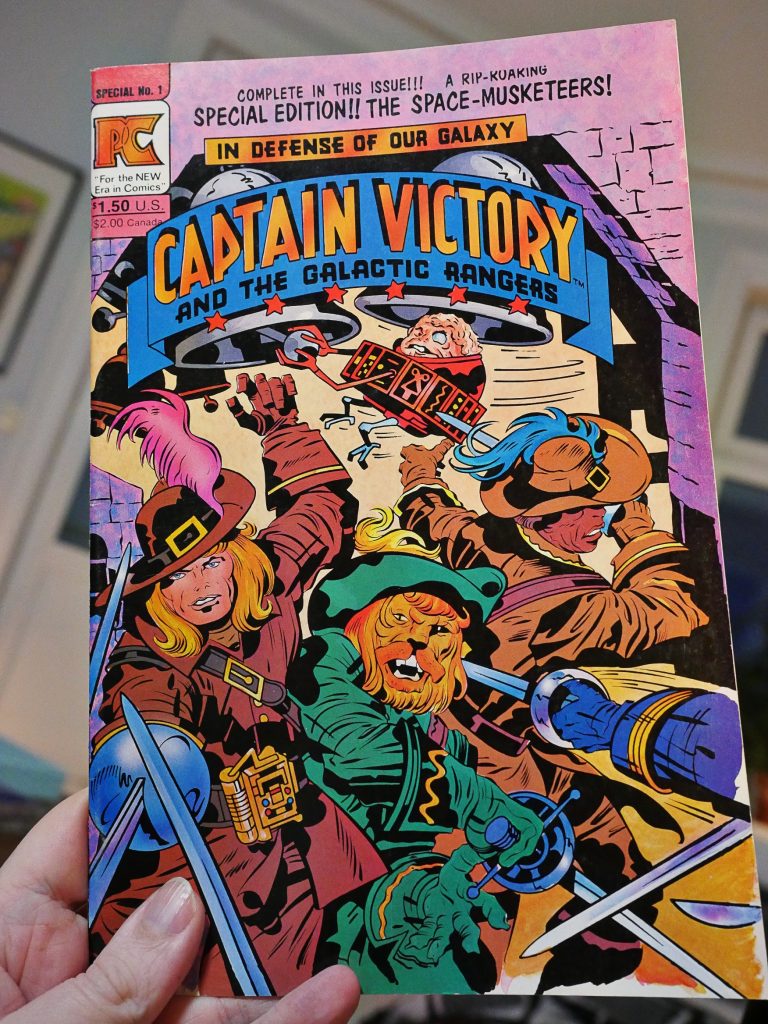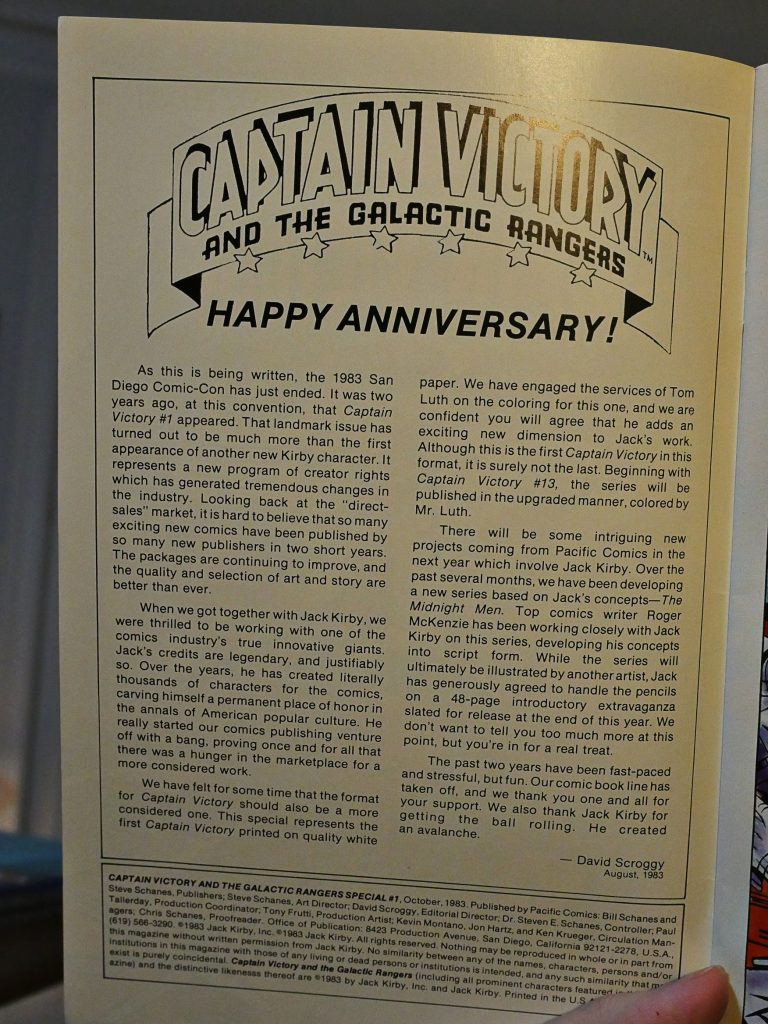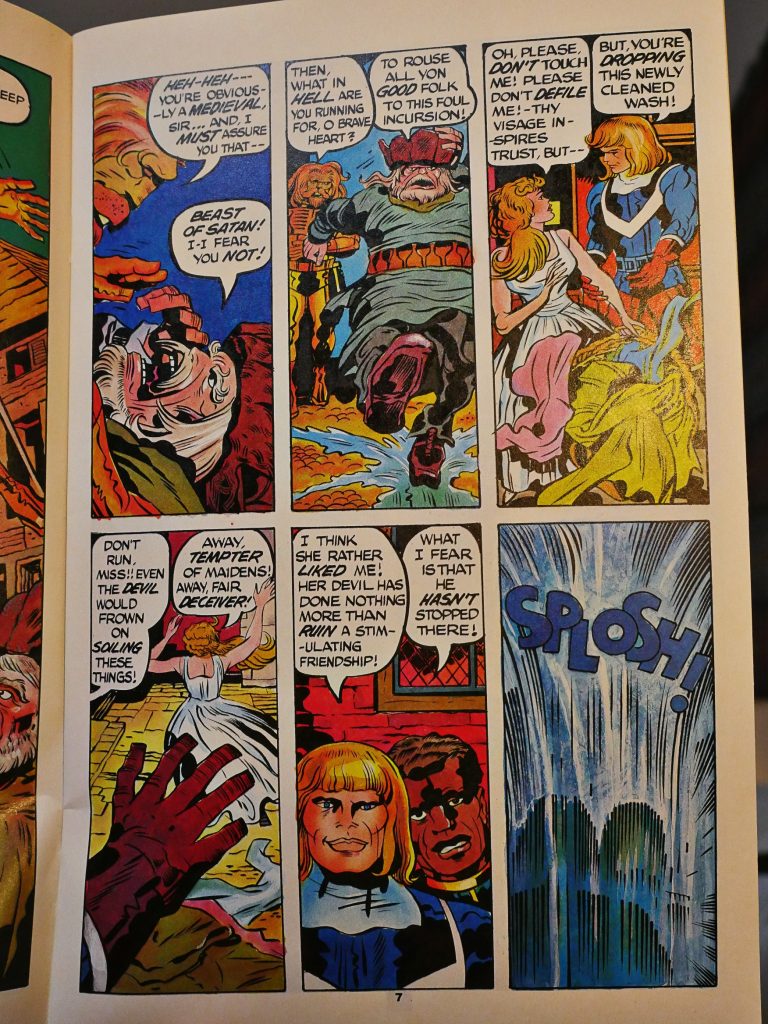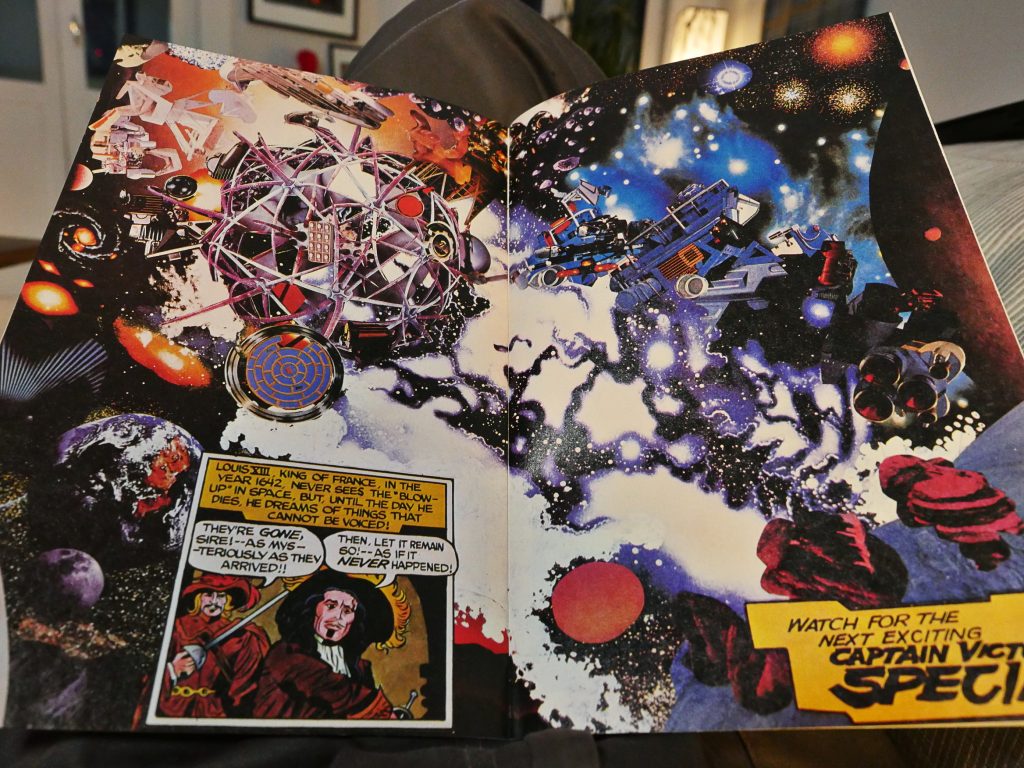The Complete Pacific Comics Re-Reading Blog Series presents:
Captain Victory and the Galactic Rangers
by Jack Kirby, Mike Royer, Michael Thibodeaux &c
Captain Victory and the Galactic Rangers (1981) #1-13,
Captain Victory and the Galactic Rangers Special (1983) #1
After dipping their toes into publishing comics with One four years earlier, Pacific Comics was ready to do a real push into the comics market now, and they wanted to launch with the biggest name possible: Jack Kirby:
We needed a creator who was a juggernaut, one which every collector and every CBSR would recognize, even if the character (s) involved would be entirely new.
Pacific Comics launched with the king, Jack Kirby, and his new creator owned title called Captain Victory.
Most people don’t know this next tidbit, but we intended on our first major release to be a project Gil Kane was working on at the time – Blackmark.
Gil very much liked our creator friendly contract, but Gil was really old school, and he wanted to have Blackmark on newsstands nationwide. Gil was quite stubborn and was challenging to have a conversation with. We didn’t believe in the newsstand channel of a viable distribution model, as the sell through percentages often were as low as 20%, and we felt the whole old school fully returnable system was so out of date and fundamentally flawed. Also, when we were going to launch our line of full color comic books, we wouldn’t have any advertising revenue, just sales from the actual comic books.
The negotiations fell through and they started with Kirby instead…
Since this is the first comic-book comic that Pacific published, I’m going to do a few more images from this comic than strictly necessary, perhaps. I bought this comic more or less as it was being published, so I was like 13 at the time. The thing is that I can’t recall a single thing about it. I can’t have disliked it, because I continued buying it until it was cancelled, but I can’t really have liked it much, either…
Anyway, we start off with a mini-bio of Kirby on the inside front cover…
… and then launch into Kirby’s latest (and, I think final) set of comic book creations. Kirby’s in cosmic sci-fi mode here, but the admittedly sizzling artwork is seriously undercut by the lacklustre printing job Pacific was getting. It’s on newsprint; sure, but the colours are way muddier than there’s any reason for them to be.
Now that’s a gnarly planet.
32 pages! With no ads!
Except these, I mean!
And this one!
Oh, I kid; those are just in-house ads, so they don’t count, right?
Anyway, Kirby is in fine fettle here, with one absurd visual concept after another sprouting from his pencil. And Mike Royer is pretty great here inking this insanity.
The story, though… It has some charm, but everything is so abrupt. I want to give myself up to the sheer oddness of it all, but it’s hard to get into it.
Cosmic!
Kirby reuses some of his earlier character concepts, though…
Hey! Nice model sheet. Kirby was working for various animation companies at this point, so doing model sheets probably felt natural.
And editor David Scroggy finishes up by announcing that Pacific will be publishing a select number of comics.
I had conservatively forecast sales on Captain Victory #1 at 35,000 copies, and when our total orders came in at over 130,000 copies, we were shocked in the best of ways. I called each distributor to reconfirm their purchase order quantities, as at first I thought many of the midsized and small distributors had put the wrong quantity down on their purchase orders. The quantities didn’t change.
Wow. 130K is a staggering number of copies to sell, especially since this was a comic book that had a cover price that was much higher than comics published by Marvel and DC at the time.
Schanes explains the business plan:
The fundamental difference was the distributor had the opportunity to earn 4 times more each time they sold a Pacific Comic Vs DC comic book or a Marvel comic book.
That does explain a lot.
The villains (an insectile species) are very evil indeed.
While Captain Victory is… er… puzzling. But good! I think! I mean, it’s probably good that he’s carrying around the most helpless form of thinking life in our galaxy? And shows it to random people? For… reasons?
ISN”T IT!?
Perhaps the reason I don’t recall this series from when I was a teenager is that it was all rather baffling.
Anyway, the printing of the second (and subsequent issues) is a lot better than the first issue. It’s still on newsprint, but the colouring is a lot less muddy, so I’m assuming they learned from whatever they were doing wrong when preparing the first issue.
The letters pages are very enthusiastic.
With the tiger.
Plenty of in-house ads for the other series that Pacific are going to publish, like the soon-to-be much-beleaguered Neal Adams comic Ms. Mystic.
Like I may have said before, the Pacific people are very business minded. Here’s a survey from the inside cover of Captain Victory #2 where they ask all kinds of impertinent questions. I mean, questions that will… er… allow the Schaneses (is that the correct pluralisation?) to… make a better… business plan?
Oh, what do I know about business plans anyway.
Pacific starts offering subscriptions to their series.
And Michael Thibodeaux takes over as the inker after Mike Royer. Thibodeaux’s inking is a lot scratchier than Royer’s. It lacks some of the visually arresting starkness, I think, but it’s still good.
Most of the characters here don’t, er, have much character, but King tries to mix stuff up by having that Mr. Mind guy being all uppity, and then the rest have to be stern and stuff. I’m not quite sure it works.
Oh! A preview of Ms. Mystic.
It’s actually kinda moving: Adams is going all in on animal rights and environmentalism here.
Oh, did I mention that the evil ones are evil? And that Kirby’s dialogue continues to be… puzzling?
In the fourth issue, Kirby adds a back-up feature.
It’s pretty goofy.
And pin-ups!
There’s a lot of Kirby pages in here, so a Kirby fan can’t complain that they’re not getting their money’s worth…
Publisher William Schanes writes about Pacific’s business concept: They “do not sell or license toys, bath towels, underwear, or anything else you can put a character on, as this is not our business”, and takes a general very strong stance for creators’ rights.
I’m not a Kirby fan. I quite like the Simon/Kirby romances, and as a child I really liked the Lee/Kirby Marvel comics, but these days I find it a chore to get through any of his non-Simon comics. But I have to say that reading these goofy comics, I find it hard not to be thrilled by the artwork. I mean, look at those aliens. Just look at them.
“No word for…” detected.
The sixth issue, which may or may not originally have been meant as the final Captain Victory issue, is 48 pages, for the same low $1 price.
And we finally get the “real” Pacific Comics logo that we all know and love.
The main feature is the same length as usual… and look at that semi-silent gearing-up sequence…
The storyline comes to a pretty gruesome conclusion. Instead of a long drawn-out heroic fight sequence, which is how you’d usually end one of these things, Captain Victory dons a weapon that sucks all the life out of everything. (Oops. Spoilers.) That’s not very heroic, and is perhaps a point Kirby wanted to make…
Hey! San Diego Comics Con.
Yes, an alien disguised as Ronald Reagan suffers Cosmic Diarrhea!
The second back-up feature is the introduction of Steve Ditko’s new hero, The Missing Man. The dialogue is by Mark Evanier, which is pretty unusual…
The Ditko feature continues in Pacific Presents, alongside newcomer Dave Stevens’ Rocketeer.
After the first arc has ended, Kirby doesn’t seem to really have a new storyline to tell, so he futzes about for a few issues with some new, great villains like Paranex, The Fighting Fetus, and spends most of the time coming up with new catch phrases.
Ursan the Unclean is pretty good, tood.
The jokes keep on coming, but this one surprisingly enough connects to a plot point later in the series.
STOP PAWING ME!
I just wanted to do that panel totally without any context.
Anyway! My guess is that perhaps these later issues would be less well-received than the earlier ones. I mean, Kirby was totally out of fashion in the early 80s, but the first six issues had a straight-forward almost standard adventure story going on, while the next four issues are very odd indeed.
Tim Conrad contributes two eight-page back up stories. For a few issues, we got 30 pages of Kirby per issue, but for the last third we’d be down to 20 pages now and then.
Conrad’s wispy lines don’t print very well on newsprint.
Sure! Sure!
I don’t remember Kirby being that violent in the 70s? Perhaps the comics code didn’t let him show Darkseid doing things like this?
Anyway, that’s Captain Victor’s father commanding the saw; this is part of the Origin Story that takes up the last three issues. I think at this point Kirby was bored by the entire thing, because things are kinda… random…
Pacific likes back-up stories. Kent Williams and Bruce Jones contributes one, and since it’s Bruce Jones, you get the requisite rape scene…
Finally! In the very last issue, the thirteenth, Pacific changes the paper stock to white paper and everything looks spiffier all of a sudden.
Cosmic, dude!
And then it’s over. “The end of the beginning!”, but it’s the end of the end.
Ed Foley closes out the series with an O Henry story about a caveman. It’s very ironic.
But wait! There’s more! There’s a Special published a few months before the final issue.
And we learn that Jack Kirby is collaborating on something called The Midnight Men with Roger McKenzie, and is going to draw the first 48 pages. This never happened, but Pacific was to go bankrupt in a few months, anyway. I tried googling the concept and found this, but otherwise I know nothing.
The special is a one-off goof where Captain Victory and his pals get to be the Three Musketeers in a time-travelling little tale. It’s not very funny: The “serious” Captain Victory issues were funnier.
Wow! Cosmic!
So… There’s some charm to Captain Victory, but it’s not really, you know, good.
Here’s the Kirbys (Kirbies?) about their working relationship with Pacific:
ROZ KIRBY: The Schanes brothers.
KIRBY: Yeah, the Schanes brothers.
ROZ KIRBY: They asked Jack if he wanted to do books for them. This was at a time when Jack never got any royalties, and they said he’d have complete control and he would get his royalties.
KIRBY: On Captain Victory I got royalties.
ROZ KIRBY: And they said, do you have another book for us? So. Jack said. what should I do? He had a 50 page synopsis for a TV show or a movie. So I said why don’t you just take this in and break it down into the comic book. So actually Silver Star was the storyboard for a movie.
GROTH: I see. Now how did that relationship work out?
ROZ KIRBY: We had to call every minute [and ask] “Where’s the money? Where’s the check?” “It’s in the mail.” [Laughter.]
KIRBY: She remembers a lot more than I do.
ROZ KIRBY: But, they usually finally got it to us.
KIRBY: Yeah, they finally got it to us, but…
ROZ KIRBY: We’re still friends.
GROTH: Did you find that to be a pretty good…
KIRBY: It was a frustrating relationship because of that kind of thing.
ROZ KIRBY: We had to get on the phone constantly.
KIRBY: In other words, it’s a question of reminding people. I didn’t like to be in that position.
ROZ KIRBY: It was embarrassing for me because I had to handle the whole thing.
But what did contemporary critics think?
Amazing Heroes #11, from an unnamed critic:
Considering that this is a direct-sales,
fan-oriented publication, there’s no
reason for such rigid conventionality. It’s
possible that Kirby’s approach to comics
has ossified to such a point that he can’t
escape the rut, but if not, he should be
encouraged to drop-kick his pet motifs,
and develop some altogether fresh con-
cepts.[…]
It should also be noted that although
the page panel divisions are humdrum
and an excess of close-ups dominate, Kir-
by’s basic rendering in this issue exhibits
more care and detail than any of his com-
ics work in the last few years.
Here’s “DT” from Amazing Heroes #26:
Captain Victory #10 perpetuates and magnifies
Kirby’s genius. His imagination is unparalleled in
its fertility; very few minds can so continuously in-
vent entire new characters, races, and universes.
It is genius displayed in dizzying momentum. His
style presently draws from the best aspects of all
his styles from the ’40s to the ’80s and throbs with
the Myse that inspires all artists.[…]
Captain Victory is Kirby’s baby and it deserves
our love.
News item from Amazing Heroes #36:
PACIFIC: JACK KIRBY’s series Captain Victory
has been cancelled with the 13th issue. Editor
DAVE SCROGGY cited low sales as the cause
for the cancellation. He did mention, however,
that a new Kirby title was being prepared to
replace this and the recently-ended Silver Star
mini-series.
Well, but that was a pretty good run for a Pacific title. At 14 issues, that’s about 10% of their total published output, and is almost twice as many issues as their second-longest-running title, Twisted Tales, which only had 8 issues out before Pacific went bankrupt.
RC Harvey in Comics Journal #67:
Printed at the Sparta (Illinois) plant
where all mainstream comics are cranked
off the big color presses, the book can’t be
faulted for its printing or appearance. Ink-
ed by longtime Kirby inker Mike Royer,
Victory has a deservedly familiar look. And
Kirby fans will doubtless be delighted to
know that the King has lost none of his
skill at depicting imposing futuristic hard-
ware. Unhappily, having said this much,
we have exhausted a catalogue of the
book’s appeals.
So it seems like it wasn’t well received at the time. But some people like it.
This interesting article by Jay Allen Sanford has this take on it:
Kirby was 76 years old, two or three generations out of touch with his audience. Captain Victory reeks of unhip dialogue steeped in ’60s kid-show tradition. If you doubt how bad the comic is, that first issue contains the line “You can bet your rootie toot tooties I’m a real alien!” Issue #4 introduces a troll-like character with a big red nose and 3-D glasses in a cringeworthy cover blurb reading, “Are you ready for the Goozlebobber!?!” Not Kirby’s best work — some would say it’s his worst — but it wasn’t as delusional as the Devil Dinosaur (and Moon-Boy) series he did for Marvel in 1978, rejected after nine issues by readers and employers alike.
[…]
Irrespective of hastily drawn artwork, the poor visuals of Captain Victory weren’t entirely Kirby’s fault. Early issues were printed on porous newsprint that absorbed the color ink, making for muddy and often illegible pages. Even the initial preproduction coloring was problematic, since nobody at Pacific had ever worked on a color comic book before.
And continues with this bit about Steve Oliff’s colours:
“I had visions of doing flat color like it had never been done before by using some of the full-color tricks I’d learned on the Hulk and Moon Knight. I even went so far as to add Zip-a-tone [pasted-on dot patterns] to Jack’s original art on Captain Victory #1 to get the added tonal values. My good intentions aside, the coloring came out dark and muddy rather than dramatic and moody.
It [Captain Victory] wasn’t the best story Jack ever wrote, and I’m afraid I really wasn’t giving it the look he wanted, so he fired me.

